Biden Administration Decides To Build A New Nuclear Bomb to Get Rid Of An Old Bomb
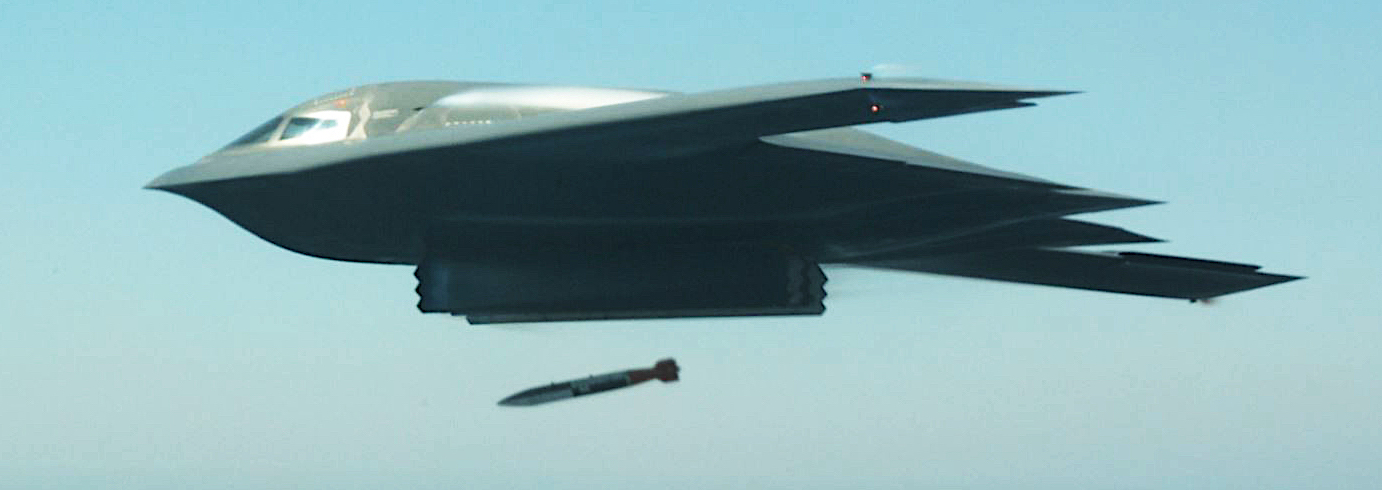
A B-2 bomber drops an unarmed B61-12 bomb in a trial. The planned B61-13, which seems intended to persuade Congress to allow retirement of the B83-1, would look the same and arm the new B-21 bomber.
[UPDATED] The Biden administration has decided to add a new nuclear gravity bomb to the US arsenal. The bomb will be known as the B61-13.
The decision to add the B61-13 comes shortly after another new nuclear bomb – the B61-12 – began full-scale production last year and is currently entering the nuclear stockpile. The administration stated that it would not increase the number of weapons in the arsenal and that any B61-13s would come at the expense of the long-planned B61-12.
According to defense officials, the B61-13 will use the warhead from the B61-7 but will be modified with new safety and use-control features as well as a guided tail kit (like the B61-12) to increase the bomb’s accuracy compared with the B61-7.
Although officials assured us that the B61-13 plan is not due to new developments in the target set, the press material from the Pentagon is more direct: B61-13 will “provides us with additional flexibility” by “providing the President with additional options against certain harder and large-area military targets.”
Like the B61-7, the B61-13 will be designed for delivery by strategic bombers: the future B-21 and, until it is retired, possibly also the B-2. It is not intended for delivery by dual-capable fighters. This decision to build the B61-13, however, appears to have less to do with a military need than striking a political deal to get rid of the last megaton-yield weapon in the US arsenal: the B83-1. This weapon was originally slated for retirement under President Obama until it was resurrected by the Trump administration; it has since become a focal point of the battle between the Biden administration, which wants to retire it, and congressional hardliners, who want to keep it.
Change Of Plan
The case for the B61-13 is strange. For the past 13 years, the sales pitch for the expensive B61-12 has been that it would replace all other nuclear gravity bombs. By re-using the B61-4 warhead, adding new safety and use-control features, and increasing accuracy with a guided tail kit, the agencies initially argued that it would be a consolidation of four existing types (B61-3/4/7/10) into a single type of gravity bomb.
Military officials have explained countless times that the B61-12 would be able to cover all gravity missions with less collateral damage than large-yield bombs. Increasing the bomb’s accuracy was the key reason why the tail kit was added, replacing the older drag parachute system of the older weapons.
By reducing the number of bomb types, the administration argued, it would be possible to reduce the total number of gravity bombs in the arsenal by 50 percent and save a substantial amount of money. Moreover, by using a warhead for the B61-12 with the least amount of fissile material, the proliferation risk from theft would be reduced, so the argument went. When the B61-10 was retired in 2016, the pitch obviously changed to consolidating three bomb types, rather than four, into one. But the Obama administration also wanted to use it to replace the ultra-high yield B83-1 and eventually the B61-11 earth-penetrator.

The Biden administration appears to have decided to build the new B61-13 nuclear bomb to persuade hardliners to get rid of the old B83-1 bomb.
The Trump administration had different interests, however, and its Nuclear Posture Review decided to retain the B83-1 (for reasons that remain unclear, and appear to have as much to do with undoing any decisions from the previous administration and little to do with military requirements or target sets) and leave the fate of the B61-11 unanswered.
When the Biden administration took over, its Nuclear Posture Review decided to proceed with retirement of the B83-1 but did not say anything about the B61-11. The Republican-controlled House did not agree and have used the years since to solicit hardline views that the B83-1 is somehow still needed.
Privately, however, Air Force and NNSA official disagreed. A high-yield gravity bomb is no longer needed and maintaining the B83-1 would cost a lot of money that could be better used elsewhere. Moreover, the NNSA production schedule is packed and adding a B83-1 life-extension program could jeopardize much more important programs. Although the B61-13 will add stress to this backlog, it will not increase the NNSA’s planned plutonium pit production schedule.
B61-13 Characteristics
Confusingly, the name B61-13 has already been used for another nuclear weapon: the future bomb intended to replace the B61-12 in the late-2030s and 2040s. That weapon was first described in NNSA’s Stockpile Stewardship and Management Plan in 2015 (see images below).
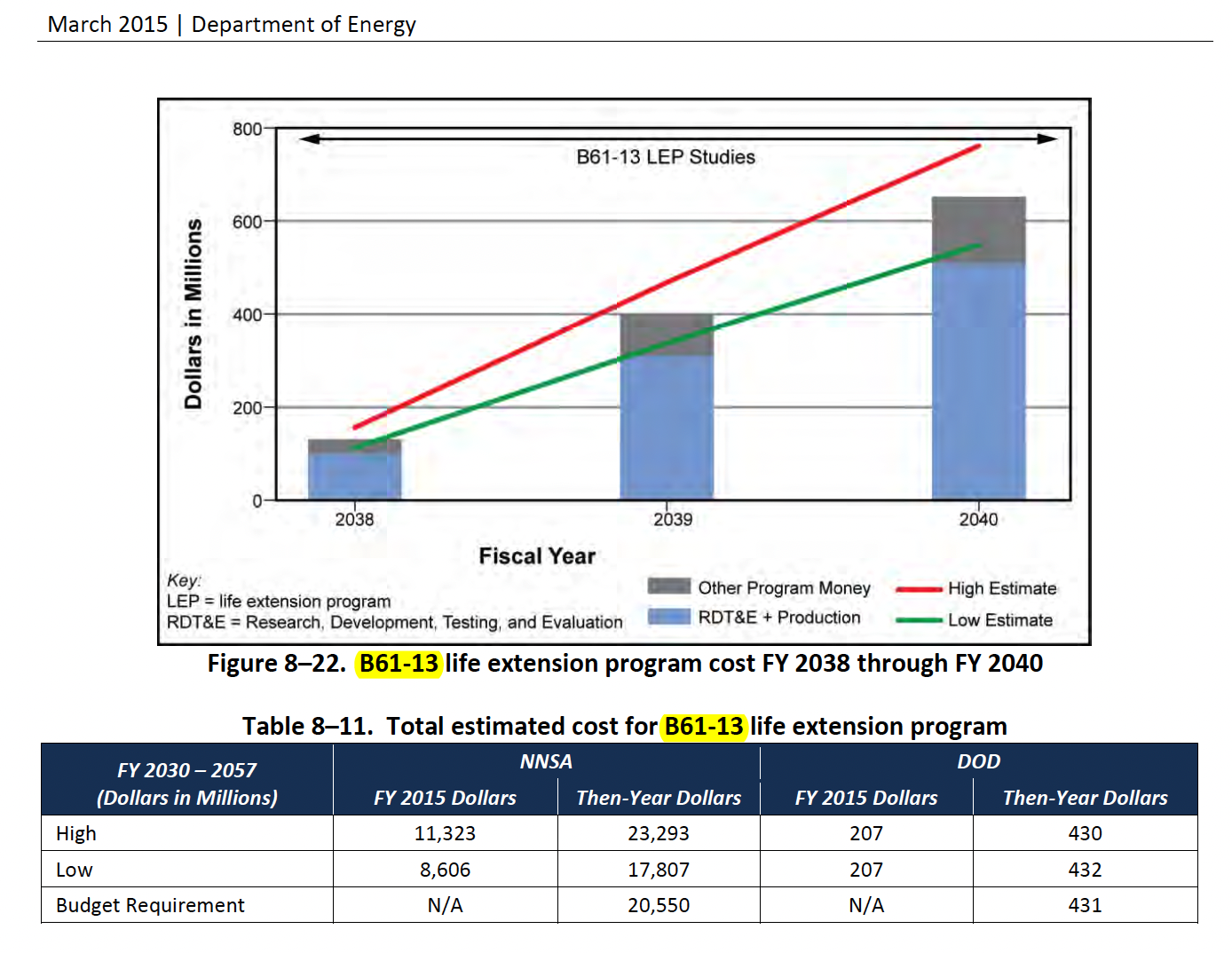
The B61-13 designation was previously given to another future nuclear bomb back in 2015.
The new B61-13 bomb will be the 13th modification of the B61 warhead design (see image below). These modifications have varied in physical appearances, yields, safety and use-control features, and delivery platforms. Five of these modifications remain in the stockpile (B61-3/4/7/11/12).
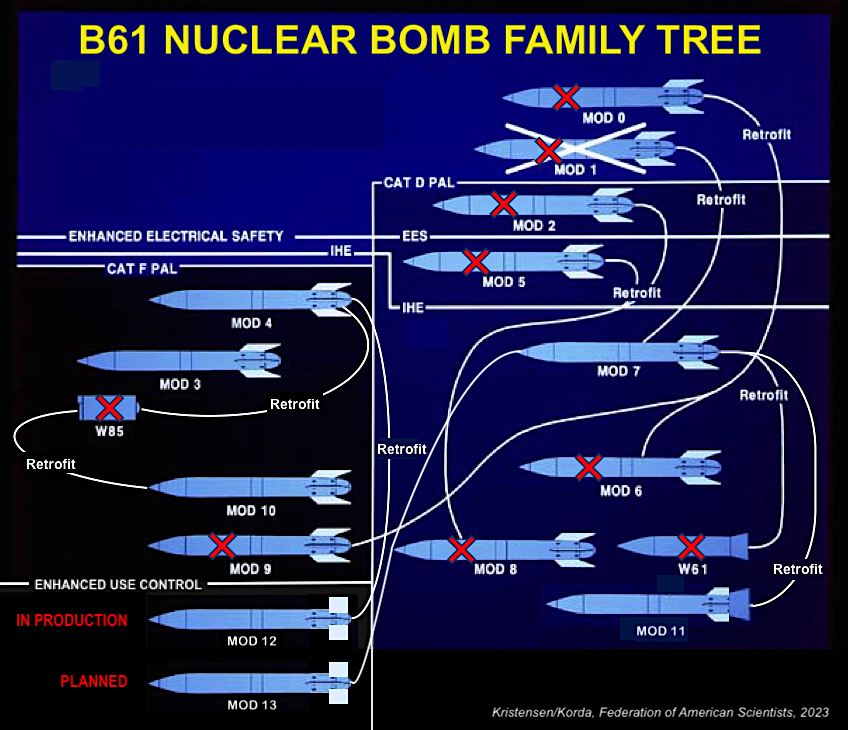
The B61-13 will be the 13th modification of the original B61 bomb. It will use the warhead from the B61-7 but with enhanced use- and security features and a guided tail kit like the B61-12 to increase accuracy.
The B61-13 will have the same maximum yield as the B61-7 (360 kilotons), according to defense officials, a significant increase compared with the 50-kiloton B61-12 it is intended to supplement. If detonated on the surface, a yield of 360 kilotons would cause significant radioactive fallout over large areas.
The effects of a 360-kiloton explosion are significantly greater than those that would result from a 50-kiloton explosion. The following map compared the radioactive fallout from a ground burst detonation in North Korea. Depending on target location and weather conditions, the fallout from a B61-13 could reach half-way across South Korea (simulation from Nukemap).
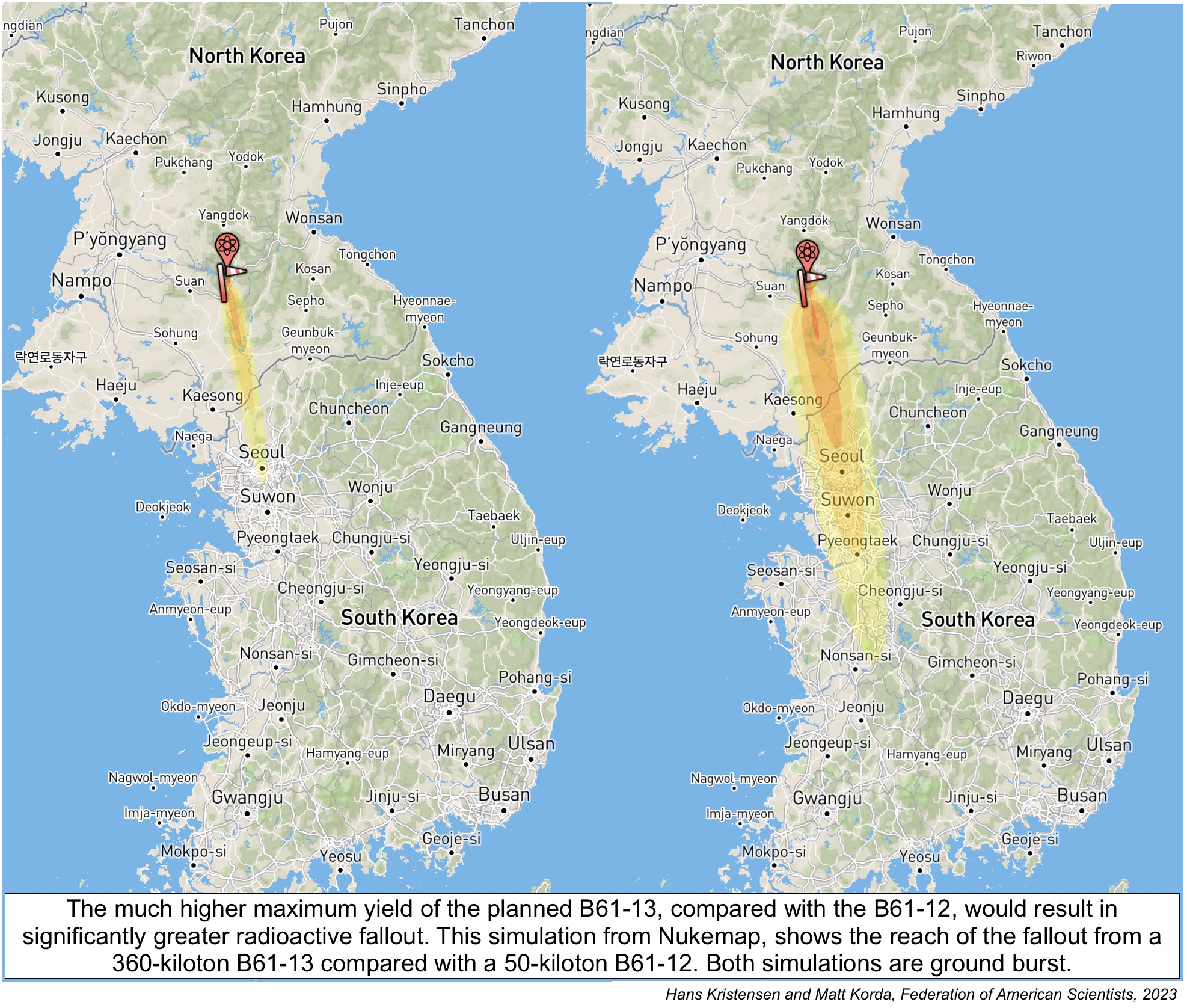
Similar to the B61-12, the B61-13 will likely also have limited earth-penetration capabilities (through soft soil), which will be enhanced by the addition of the guided tail kit. Due to the phenomenon of ground-shock coupling, the B61-13’s relatively high yield and accuracy will likely enable the bomb to strike underground targets with yields equivalent to a surface-burst weapon of more than one megaton. The B61-13 will also have lower-yield options (see table below).
Although government officials insist that the B61-13 plan is not driven by new developments in adversarial countries or a new military targeting requirement, increasing the accuracy of a high-yield bomb obviously has targeting implications. Detonating the weapon closer to the target will increase the probably that the target is destroyed, and a very hard facility could hypothetically be destroyed with one B61-13 instead of two B61-12s. The DOD says the B61-13 will “provides us with additional flexibility” by “providing the President with additional options against certain harder and large-area military targets.”
Once the B61-12 and B61-13 are produced and stockpiled, the older versions replaced, and the B83-1 retired, the changes to the gravity weapons inventory will look something like this:

Although the B61-12 was previously said to also allow retirement of the B61-11 earth-penetrator, the B61-13 plan only appears intended to facilitate retirement of the B83-1. There is currently no life-extension program for the B61-11. The plan might be to allow it to age out. Officials say the B61-13 plan does not preclude that the United States potentially decides in the future to field a new nuclear earth-penetrator to replace the B61-11. But there is no decision on this yet.
Defense officials explain that the new B61-13 will not result in an increase of the overall number of warheads in the stockpile. The reason is that the administration plans to reduce the number of B61-12s produced by the number of B61-13s produced, so the total number of new bombs will ultimately be the same. The production plan for the B61-12 involved an estimated 480 bombs for both strategic bombers and dual-capable fighters. Since the bombers will now carry both B61-12 and B61-13 bombs (in addition to the new LRSO cruise missiles), and because the actual number of targets requiring a high-yield gravity bomb is probably small, it seems likely that the number of B61-13 bombs to be produced is very limited – perhaps on the order of 50 weapons – and that production will happen at the back end of the B61-12 schedule in 2025.
Unlike the B61-12s – of which a portion will be forward-deployed to Europe for use with NATO’s dual-capable aircraft – all of the B61-13s will be stored within the United States for use with the incoming B-21 bomber and the B-2 bomber (until it is replaced by the B-21). Nonetheless, because the B61-13 will use the same mechanical and electronic interface as the B61-12, the fighters that are destined to deliver the B61-12 will also be capable of delivering the B61-13. But the current plan is that the B61-13 is only for the bombers.
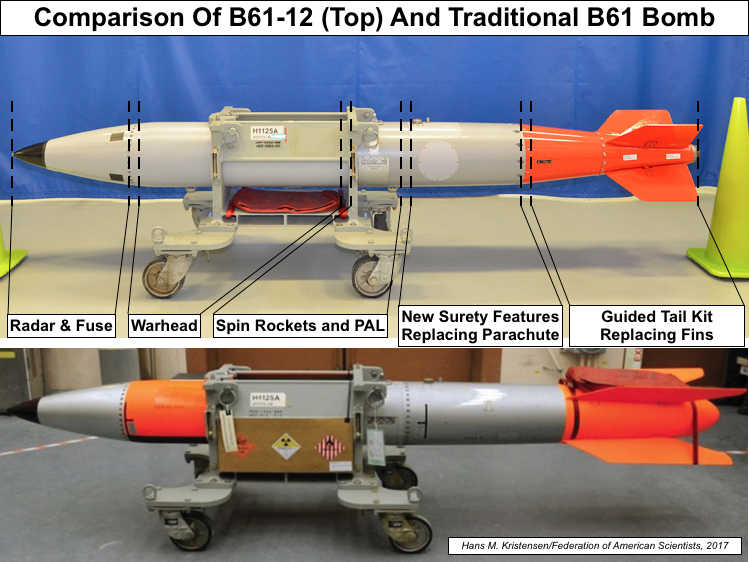
The B61-13 will look identical to the B61-12 (top) but use a much more powerful warhead from the B61-7. It is intended for delivery by bombers but can technically also be delivered by fighter jets (although that is not planned).
A Political Nuclear Bomb
The military justification for adding the B61-13 to the stockpile is hard to see. Instead, it seems more likely to be a political maneuver to finally get rid of the B83-1.
Defense officials say that the decision is not related to current events or developments in China, Russia, or other potential adversaries. Nor is the administration’s decision a product of the hard and deeply buried target capability study mentioned in the 2022 Nuclear Posture Review.
The B61-13 is a separate decision, they explain.
The military doesn’t need an additional, more powerful gravity bomb. In fact, Air Force officials privately say the military mission of nuclear gravity bombs is decreasing in importance because of the risk of putting bombers and their pilots in harm’s way over heavily defended targets – particularly as long-range missiles are becoming more capable.
To that end, the military mission of the B61-13 is somewhat of a mystery, especially given that the LRSO will also be arming the bombers and that the United States has thousands of other high-yield weapons in its arsenal.
Instead, what appears to have happened is this: after defense hardliners blocked the administration’s plans to retire the B83-1, the administration likely agreed to retain the B61-7 yield in the stockpile in the form of a modern bomb modification (B61-13) that is easier and cheaper to maintain, so that they can finally proceed with the retirement of the B83-1.
As such, the B61-13 will be the second “political” weapon in recent memory. The first was the low-yield W76-2 warhead fielded in late-2019 on the Trident submarines. The next one could be a nuclear sea-launched cruise missile (SLCM-N), if defense hawks have their way.
Additional Information
• US nuclear weapons, 2023
• The B61 Family of Nuclear Bombs
This research was carried out with generous contributions from the New-Land Foundation, Ploughshares Fund, the Prospect Hill Foundation, Longview Philanthropy, and individual donors.
Upgrade Underway for Russian Silos to Receive New Sarmat ICBM
New satellite imagery shows that preparations to deploy Russia’s new RS-28 Sarmat (SS-29) intercontinental ballistic missile (ICBM) are well underway.
However, the imagery also indicates that President Putin’s claims of deployment “in the near future” may be too optimistic. It is potentially possible that one or two missiles could be deployed early, but major construction is still ongoing at many of the silos in the first regiment and has not yet begun at all of them, and the completion of construction at all eventual Sarmat regiments may be over a decade away.
The Sarmat––which was originally scheduled to enter service between 2018 and 2020 and will replace Russia’s aging RS-20V Voevoda (SS-18) ICBM––had been subject to significant manufacturing, production, and testing delays. In January 2022, the “War Bolts” Telegram channel reported that flight tests for Sarmat had been postponed due to problems with the missile’s command module. Following Sarmat’s eventual first test flight on 20 April 2022, Putin announced that the new ICBM would enter combat duty by the end of the year. As of October 2023, however, only one additional Sarmat flight test had reportedly taken place (in February 2023) and, according to US officials, likely ended in failure.
Despite the lack of successful tests, in November 2022 the General Director of the Makeyev Rocket Design Bureau––responsible for the design of Sarmat––claimed that the missile had already entered serial production. On 1 September 2023, Roscosmos Chief Yury Borisov announced that Sarmat had “assumed combat alert posture,” although this was likely premature: on 5 October 2023, President Putin noted during his speech at the Valdai Club that some “administrative and bureaucratic procedures” still needed to be carried out before Sarmat could be placed on combat duty, and on 7 October 2023, the Russian Ministry of Defence noted on Telegram that the “final stages” of construction and installation were still underway at the first launch facilities and associated command post.
New satellite imagery indicates construction is well underway at the first regiment of the 62nd Missile Division near Uzhur in south Siberia. It is expected that a total of 46 Sarmat missiles will eventually be deployed with seven regiments (six missiles per regiment, plus one 10-missile regiment) in two divisions at Uzhur and Dombarovsky.
The first missile regiment undergoing its upgrade to Sarmat is the 302nd Missile Regiment and consists of six silos. Major construction continues at the launch control center and its accompanying silo (12C) and three other silos (13C, 15C, and 17C). The two remaining silos (16C and 18C) have only received minor upgrades and will take many months to complete if scheduled for the same comprehensive upgrade as the other silos.
Silos 12C and 17C:
The first two silos to begin their upgrades were Silos 12C (55.1144°, 89.6344°) and 17C (55.0347°, 89.7286°), which began their upgrades in the spring and summer of 2021, respectively. Over the past two years, the perimeters at both sites were removed, reshaped, and expanded with additional layers of fencing. The surface area of both silos has nearly doubled in size: Silo 12C has been expanded from approximately 0.228 square kilometers to 0.427 square kilometers, and the area of Silo 17C has been expanded from approximately 0.082 square kilometers to 0.136 square kilometers.
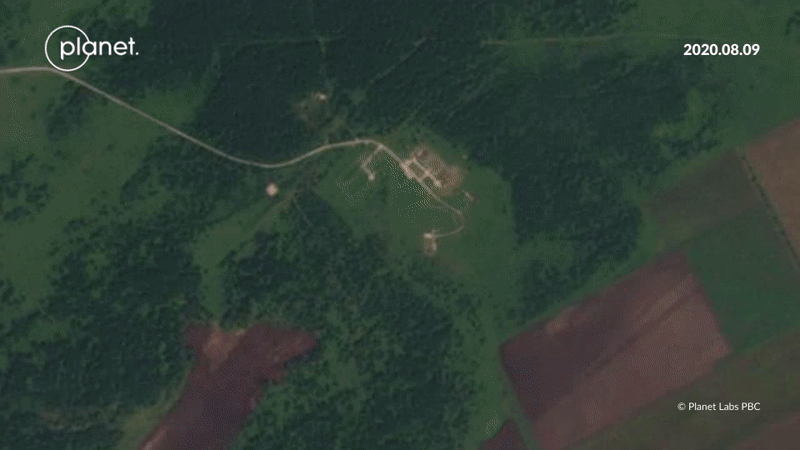
As of mid-September, construction appeared to be nearly complete inside the inner silo areas at both sites. The launch control center at Silo 12C has been upgraded to a newer LCC design that can also be seen at other Russian ICBM complexes, including the SS-27 Mod 1 “Topol-M” silo field near Tatishchevo, the SS-27 Mod 2 “Yars” silo field near Kozelsk, and the SS-19 Mod 4 “Avangard” silo field near Dombarovsky. In addition, Silo 12C boasts a new gun turret placement and expanded administrative area, although this outer area is not yet complete.
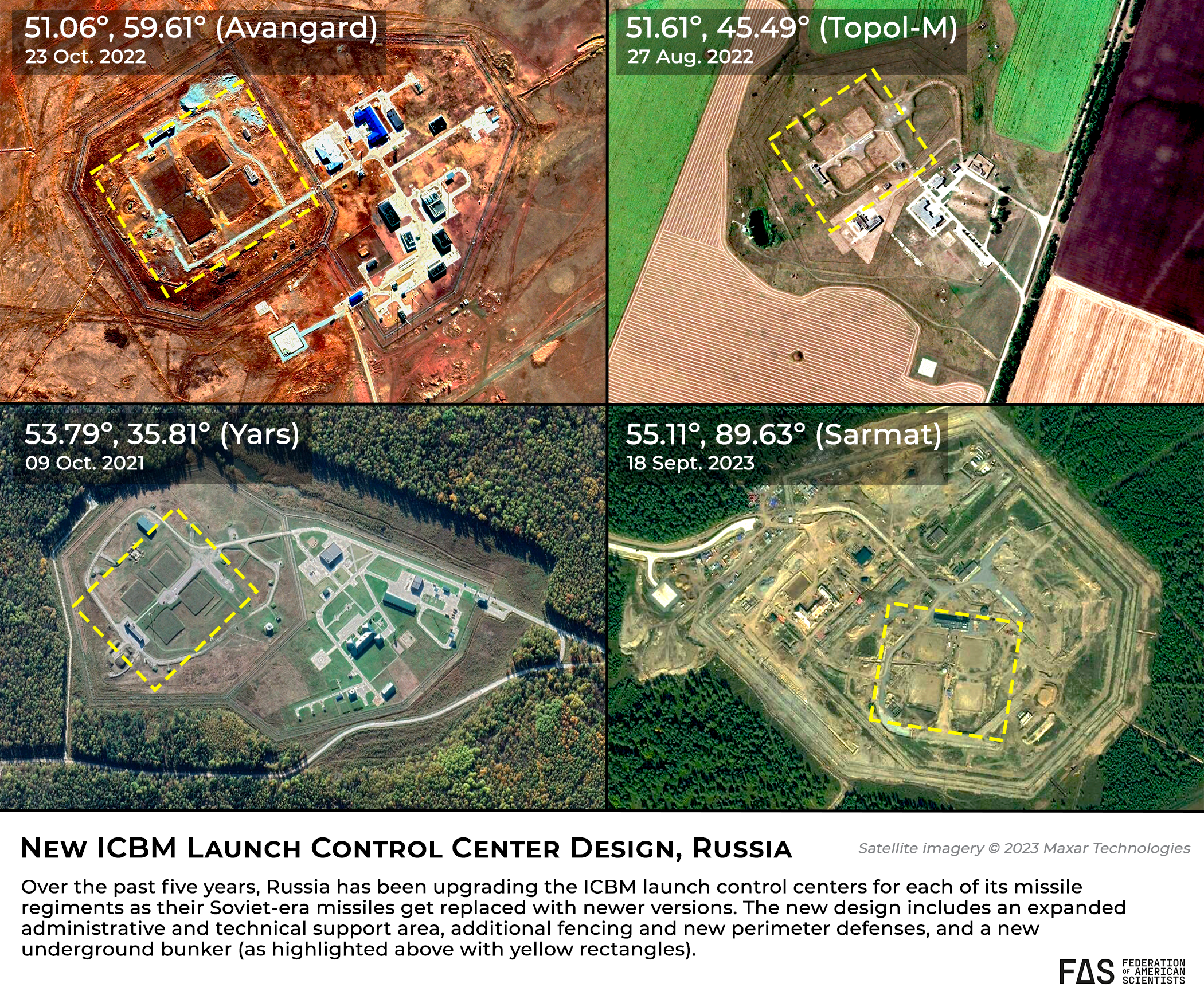
Notably, the immediate area surrounding Silo 17C has been subject to significant wildfire damage in the past. In 2017, a wildfire burned through all three sets of perimeter fencing and damaged the inner road leading to the silo hatch. In May 2021, another wildfire again burned through the three layers of fencing and appeared to damage an administrative building near the hatch.
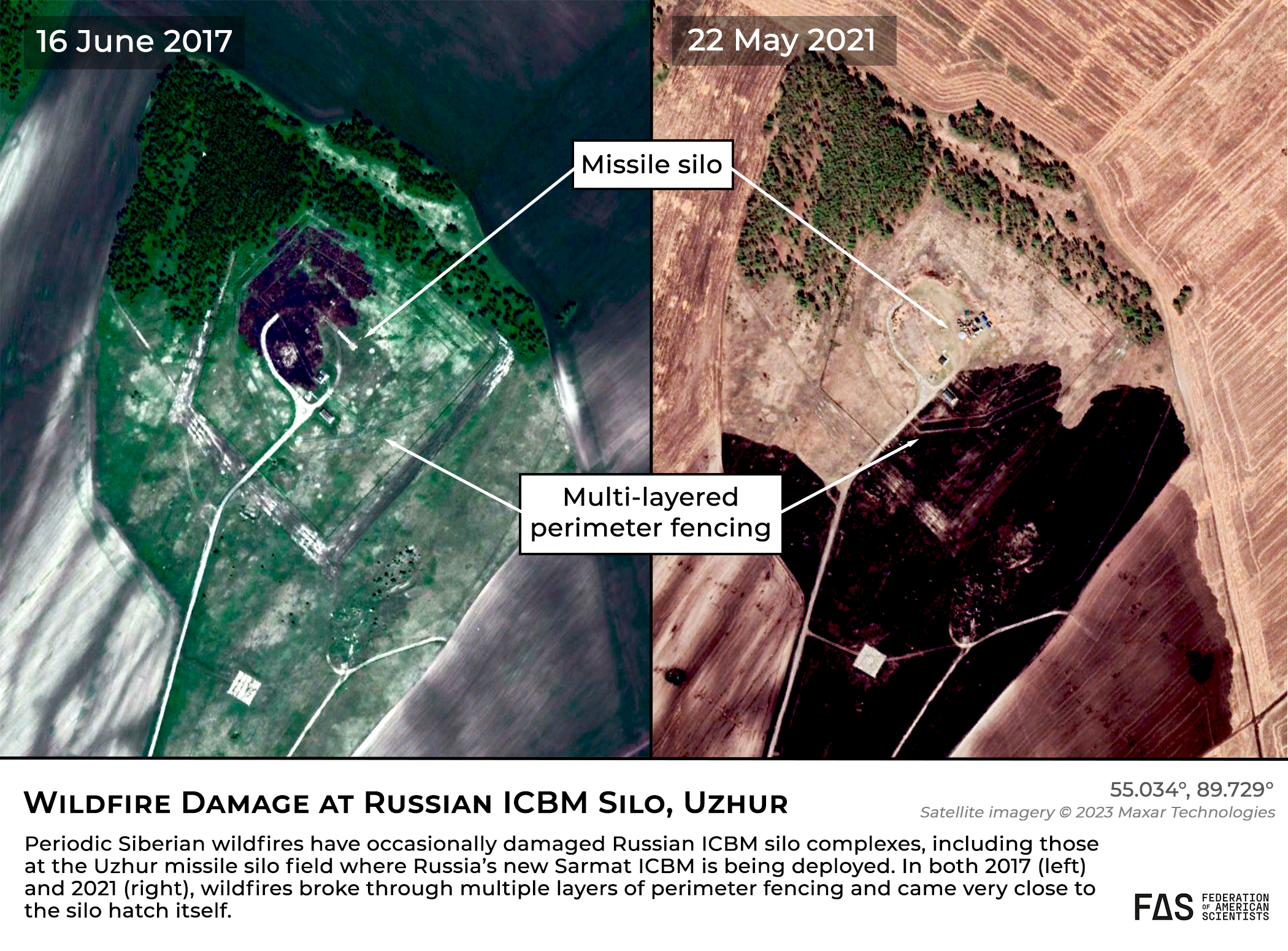
Silos 13C and 15C:
Silos 13C (55.2008°, 89.7061°) and 17C (55.0822°, 89.8155°) began their upgrades in late-2022, nearly 1.5 years after construction on the first two silos began. As of mid-October 2023, significant construction at both sites was still underway, including underground and inside the silos themselves. Trees have been removed at both sites to make space for the expanded perimeter fences. While the new perimeters at both sites have been marked out, the multiple layers of fencing have not yet been completed. New gun turrets at both sites now appear to be in place.
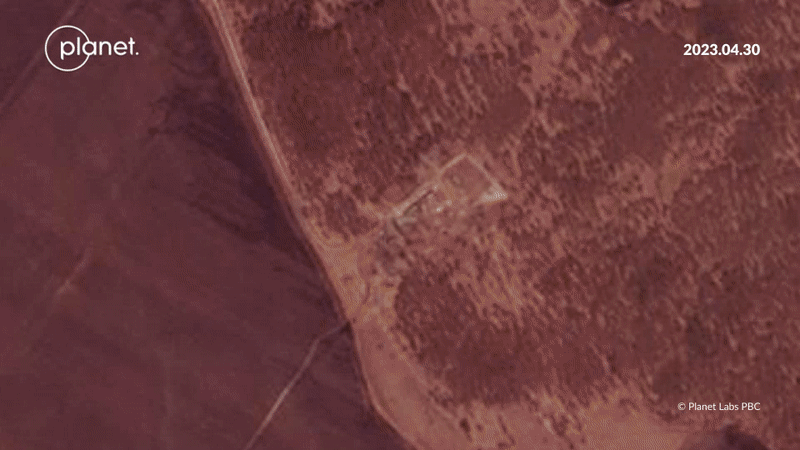
Use the Planet Labs PBC interactive slider to compare before/after images.
Silos 16C and 18C:
As of mid-September 2023, full-site construction at Silos 16C (55.0247º, 89.5711º) and 18C (54.9501º, 89.6833º) had not yet begun, although some silo maintenance work has been visible since mid-2021, possibly in preparation for the full-site construction.
Open silos
It is notable that satellites have managed to capture images of all four silos currently under construction with their hatches open; on more than one occasion, multiple different silos could be seen with their hatches open on the same day, and in some cases hatches have stayed open for days at a time. This suggests that operations to upgrade the silos themselves and preparations to deploy Sarmat ICBMs inside them––as touted by high-ranking Russian officials––are well underway.
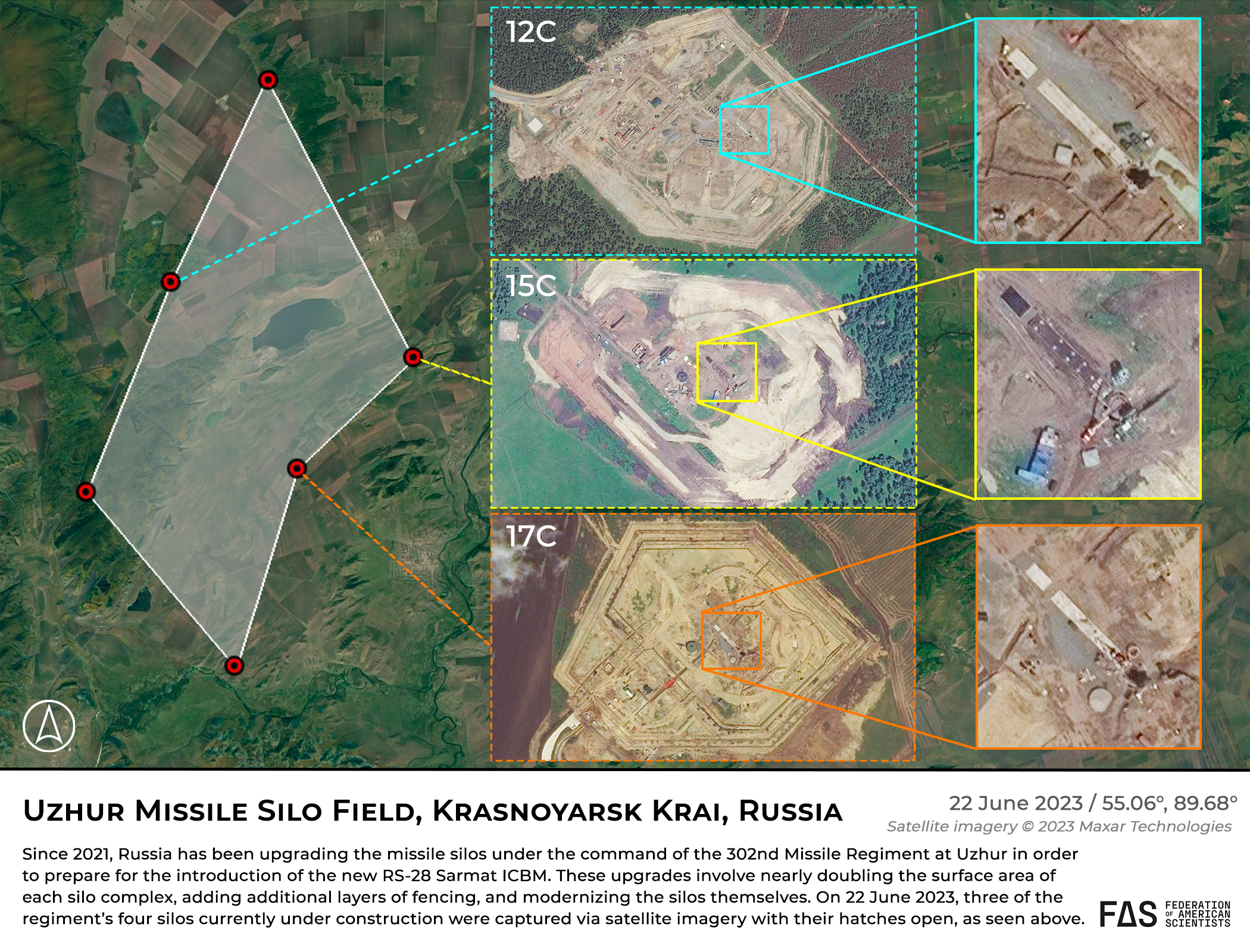
Additional information:
• Nuclear Notebook: Russian Nuclear Weapons, 2023
This research was carried out with generous contributions from the New-Land Foundation, Ploughshares Fund, the Prospect Hill Foundation, Longview Philanthropy, and individual donors.
Strategic Posture Commission Report Calls for Broad Nuclear Buildup
On October 12th, the Strategic Posture Commission released its long-awaited report on U.S. nuclear policy and strategic stability. The 12-member Commission was hand-picked by Congress in 2022 to conduct a threat assessment, consider alterations to U.S. force posture, and provide recommendations.
In contrast to the Biden administration’s Nuclear Posture Review, the Congressionally-mandated Strategic Posture Commission report is a full-throated embrace of a U.S. nuclear build-up.
It includes recommendations for the United States to prepare to increase its number of deployed warheads, as well as increasing its production of bombers, air-launched cruise missiles, ballistic missile submarines, non-strategic nuclear forces, and warhead production capacity. It also calls for the United States to deploy multiple warheads on land-based intercontinental ballistic missiles (ICBMs) and consider adding road-mobile ICBMs to its arsenal.
The only thing that appears to have prevented the Commission from recommending an immediate increase of the U.S. nuclear weapons stockpile is that the weapons production complex currently does not have the capacity to do so.
The Commission’s embrace of a U.S. nuclear buildup ignores the consequences of a likely arms race with Russia and China (in fact, the Commission doesn’t even consider this or suggest other steps than a buildup to try to address the problem). If the United States responds to the Chinese buildup by increasing its own deployed warheads and launchers, Russia would most likely respond by increasing its deployed warheads and launchers. That would increase the nuclear threat against the United States and its allies. China, who has already decided that it needs more nuclear weapons to stand up to the existing U.S. force level (and those of Russia and India), might well respond to the U.S and Russian increases by increasing its own arsenal even further. That would put the United States back to where it started, feeling insufficient and facing increased nuclear threats.
Framing and context
The Commission’s report is generally framed around the prospect of Russian and Chinese strategic military cooperation against the United States. The Commission cautions against “dismissing the possibility of opportunistic or simultaneous two-peer aggression because it may seem improbable,” and notes that “not addressing it in U.S. strategy and strategic posture, could have the perverse effect of making such aggression more likely.” The Commission does not acknowledge, however, that building up new capabilities to address this highly remote possibility would likely kick the arms race into an even higher gear.
The report acknowledges that Russia and China are in the midst of large-scale modernization programs, and in the case of China, significant increases to its nuclear stockpile. This accords with our own assessments of both countries’ nuclear programs. However, the report’s authors suggest that these changes fundamentally call into question the United States’ assured retaliatory capabilities, and state that “the current U.S. strategic posture will be insufficient to achieve the objectives of U.S. defense strategy in the future….”
The Commission appears to base this conclusion, as well as its nuclear strategy and force structure recommendations, squarely on numerically-focused counterforce thinking: if China increases its posture by fielding more weapons, that automatically means the United States needs more weapons to “[a]ddress the larger number of targets….” However, the survivability of the US ballistic missile submarines should insulate the United States against needing to subscribe to this kind of thinking.
In 2012, a joint DOD/DNI report acknowledged that because of the US submarine force, Russia would not achieve any military advantage against the United States by significantly increasing the size of its deployed nuclear forces. In that 2012 study, both departments concluded that the “Russian Federation…would not be able to achieve a militarily significant advantage by any plausible expansion of its strategic nuclear forces, even in a cheating or breakout scenario under the New START Treaty, primarily because of the inherent survivability of the planned U.S. Strategic force structure, particularly the OHIO-class ballistic missile submarines, a number of which are at sea at any given time.” [Emphasis added.] Why would this logic not apply to China as well? Although China’s nuclear arsenal is undoubtedly growing, why would it fundamentally alter the nature of the United States’ assured retaliatory capability while the United States is confident in the survivability of its SSBNs?
In this context, it is worth reiterating the words of Secretary of Defense Lloyd Austin at the U.S. Strategic Command Change of Command Ceremony: “We all understand that nuclear deterrence isn’t just a numbers game. In fact, that sort of thinking can spur a dangerous arms race…deterrence has never been just about the numbers, the weapons, or the platforms.”
Force structure
Although the report says the Commission “avoided making specific force structure recommendations” in order to “leave specific material solution decisions to the Executive Branch and Congress,” the list of “identified capabilities beyond the existing program of record (POR) that will be needed” leaves little doubt about what the Commission believes those force structure decisions should be.
Strategic posture alterations
The Commission concludes that the United States “must act now to pursue additional measures and programs…beyond the planned modernization of strategic delivery vehicles and warheads may include either or both qualitative and quantitative adjustments in the U.S. strategic posture.”
Specifically, the Commission recommends that the United States should pursue the following modifications to its strategic nuclear force posture “with urgency:” [our context and commentary added below]
- Prepare to upload some or all of the nation’s hedge warheads; [these warheads are currently in storage; increasing deployed warheads above 1,550 is prohibited by the New START treaty (which expires in early-2026) and would likely cause Russia to also increase its deployed warheads.]
- Plan to deploy the Sentinel ICBM in a MIRVed configuration; [the Sentinel appears to be capable of carrying two MIRV but current plan calls for each missile to be deployed with just a single warhead]
- Increase the planned number of deployed Long-Range Standoff Weapons; [the Air Force currently has just over 500 ALCMs and plans to build 1,087 LRSOs (including test-flight missiles), each of which costs approximately $13 million]
- Increase the planned number of B-21 bombers and the tankers an expanded force would require; [the Air Force has said that it plans to purchase at least 100 B-21s]
- Increase the planned production of Columbia SSBNs and their Trident ballistic missile systems, and accelerate development and deployment of D5LE2; [the Navy currently plans to build 12 Columbia-class SSBNs and an increase would not happen until after the 12th SSBN is completed in the 2040s]
- Pursue the feasibility of fielding some portion of the future ICBM force in a road mobile configuration; [historically, any efforts to deploy road-mobile ICBMs in the United States have been unsuccessful]
- Accelerate efforts to develop advanced countermeasures to adversary IAMD; and
- Initiate planning and preparations for a portion of the future bomber fleet to be on continuous alert status, in time for the B-21 Full Operational Capability (FOC) date.” [Bombers currently regularly practice loading nuclear weapons as part of rapid-takeoff exercises. Returning bombers to alert would revert the decision by President H.W. Bush in 1991 to take bombers off alert. In 2021, the Air Force’s Deputy Chief of Staff for Strategic Deterrence and Nuclear Integration stated that keeping the bomber fleet on continuous alert would exhaust the force and could not be done indefinitely]
Nonstrategic posture alterations
The Commission appears to want the United States to bolster its non-strategic nuclear forces in Europe, and begin to deploy non-strategic nuclear weapons in the Indo-Pacific theater: “Additional U.S. theater nuclear capabilities will be necessary in both Europe and the Indo-Pacific regions to deter adversary nuclear use and offset local conventional superiority. These additional theater capabilities will need to be deployable, survivable, and variable in their available yield options.” Although the Commission does not explicitly recommend fielding either ground-launched theater nuclear capabilities or a nuclear sea-launched cruise missile for the Navy, it seems clear that these capabilities would be part of the Commission’s logic.
The United States used to deploy large numbers of non-strategic nuclear weapons in the Indo-Pacific region during the Cold War, but those weapons were withdrawn in the early 1990s and later dismantled as U.S. military planning shifted to rely more on advanced conventional weapons for limited theater options. Despite the removal of certain types of theater nuclear weapons after the Cold War, today the President maintains a wide range of nuclear response options designed to deter Russian and Chinese limited nuclear use in both regions––including capabilities with low or variable yields. In addition to ballistic missile submarines and nuclear-capable bombers operating in both regions, the U.S. Air Force has non-strategic B61 nuclear bombs for dual-capable aircraft that are intended for operations in both regions if it becomes necessary. The Navy now also has a low-yield warhead on its SSBNs––the W76-2––that was fielded specifically to provide the President with more options to deter limited scenarios in those regions. It is unclear why these existing options, as well as several additional capabilities already under development––including the incoming Long-Range Stand-Off Weapon––would be insufficient for maintaining regional deterrence.
The Commission specifically recommends that the United States should “urgently” modify its nuclear posture to “[p]rovide the President a range of militarily effective nuclear response options to deter or counter Russian or Chinese limited nuclear use in theater.” Although current plans already provide the President with such options, the Commission “recommends the following U.S. theater nuclear force posture modifications:
Develop and deploy theater nuclear delivery systems that have some or all of the following attributes: [our context and commentary added below]
- Forward-deployed or deployable in the European and Asia-Pacific theaters [The United States already has dual-capable fighters and B61 bombs earmarked for operations in the Asia-Pacific theaters, backed up by bombers with long-range cruise missiles];
- Survivable against preemptive attack without force generation day-to-day;
- A range of explosive yield options, including low yield [US nuclear forces earmarked for regional options already have a wide range of low-yield options];
- Capable of penetrating advanced IAMD with high confidence [F-35A dual-capable aircraft, the B-21 bomber, and air-launched cruise missiles are already being developed with enhanced penetration capabilities]; and
- Operationally relevant weapon delivery timeline (promptness) [the US recently fielded the W76-2 warhead on SSBNs to provide prompt theater capability in limited scenarios and is developing new prompt conventional missiles].”
Unlike U.S. low-yield theater nuclear weapons, the Commission warns that China’s development of “theater-range low-yield weapons may reduce China’s threshold for using nuclear weapons.” Presumably, the same would be true for the United States threshold if it followed the Commission’s recommendation to increase deployed (or deployable) non-strategic nuclear weapons with low-yield capabilities in the Indo-Pacific theater.
Strategy
Overall, the Commission suggests that current U.S. nuclear strategy is basically sound, but just needs to be backed up with additional weapons and industrial capacity. However, by not including recommendations to modify presidential nuclear employment guidance –– or even considering such an adjustment, which could reshape U.S. force posture to allow for decreased emphasis on counterforce targeting –– the Commission has limited its own flexibility to recommend any options other than simply adding more weapons.
Three scholars recently proposed a revised nuclear strategy that they concluded would reduce weapons requirements yet still be sufficient to adequately deter Russia and China. The central premise of reducing the counterforce focus is similar to a study that we published in 2009. In contrast, the Commission appears to have assumed an unchanged nuclear strategy and instead focused intensely on weapons and numbers.
The Commission report does not explain how it gets to the specific nuclear arms additions it says are needed. It only provides generic descriptions of nuclear strategy and lists of Chinese and Russian increases. The reason this translates into a recommendation to increase the US nuclear arsenal appears to be that the list of target categories that the Commission believes need to be targeted is very broad: “this means holding at risk key elements of their leadership, the security structure maintaining the leadership in power, their nuclear and conventional forces, and their war supporting industry.”
This numerical focus also ignores years of adjustments made to nuclear planning intended to avoid excessive nuclear force levels and increase flexibility. When asked in 2017 whether the US needed new nuclear capabilities for limited scenarios, then STRATCOM commander General John Hyten responded:
“[W]e actually have very flexible options in our plans. So if something bad happens in the world and there’s a response and I’m on the phone with the Secretary of Defense and the President and the entire staff, …I actually have a series of very flexible options from conventional all the way up to large-scale nuke that I can advise the President on to give him options on what he would want to do… So I’m very comfortable today with the flexibility of our response options… And the reason I was surprised when I got to STRATCOM about the flexibility, is because the last time I executed or was involved in the execution of the nuclear plan was about 20 years ago and there was no flexibility in the plan. It was big, it was huge, it was massively destructive, and that’s all there. We now have conventional responses all the way up to the nuclear responses, and I think that’s a very healthy thing.”
While advocating integrated deterrence and a “whole of government” approach, the Commission nonetheless sets up an artificial dichotomy between conventional and nuclear capabilities: “The objectives of U.S. strategy must include effective deterrence and defeat of simultaneous Russian and Chinese aggression in Europe and Asia using conventional forces. If the United States and its Allies and partners do not field sufficient conventional forces to achieve this objective, U.S. strategy would need to be altered to increase reliance on nuclear weapons to deter or counter opportunistic or collaborative aggression in the other theater.”
Arms control
The Commission recommends subjugating nuclear arms control to the nuclear build-up: “The Commission recommends that a strategy to address the two-nuclear-peer threat environment be a prerequisite for developing U.S. nuclear arms control limits for the 2027-2035 timeframe. The Commission recommends that once a strategy and its related force requirements are established, the U.S. government determine whether and how nuclear arms control limits continue to enhance U.S. security.”
Put another way, this constitutes a recommendation to participate in an arms race, and then figure out how to control those same arms later.
The Commission report does acknowledge the importance of arms control, and notes that “[t]he ideal scenario for the United States would be a trilateral agreement that could effectively verify and limit all Russian, Chinese, and U.S. nuclear warheads and delivery systems, while retaining sufficient U.S. nuclear forces to meet security objectives and hedge against potential violations of the agreement.” (p.85) However, the prospect of this “ideal scenario” coming true would become increasingly unlikely if the United States significantly built up its nuclear forces as the Commission recommends.
Capacity and budget
The Commission recommends an overhaul and expansion of the nuclear weapons design and production capacity. That includes full funding of all NNSA recapitalization efforts, including pit production plans, even though the Government Accountability Office has warned that the program faces serious challenges and budget uncertainties. The Commission appears to brush aside concerns about the proposed pit production program.
Overall, the report does not seem to acknowledge any limits to defense spending. Amid all of the Commission’s recommendations to increase the number of strategic and tactical nuclear systems, there is almost no mention of cost in the entire report. Fulfilling all of these recommendations would require a significant amount of money, and that money would have to come from somewhere.
For example, the Congressional Budget Office estimates that developing the SLCM-N alone would cost an estimated $10 billion until 2030, not to mention another $7 billion for other tactical nuclear weapons and delivery systems. The amount of money it would take to field new systems, in addition to addressing other vital concerns such as IAMD, means funding would necessarily be cut from other budget priorities.
The true costs of these systems are not only the significant funds spent to acquire them, but also the fact that prioritizing these systems necessarily means deprioritizing other domestic or foreign policy initiatives that could do more to increase US security.
Implications for U.S. Nuclear Posture
The Strategic Posture Commission report is, in effect, a congressionally-mandated rebuttal to the Biden administration’s Nuclear Posture Review, which many in Congress have critiqued for not being hawkish enough. The report does not describe in detail its methodology for how it arrives at its force buildup recommendations, and includes several claims and assumptions about nuclear strategy that have been critiqued and called into question by recent scholarship. In some respects, it reads more like an industry report than a Congressionally-mandated study.
While the timing of the report means that it is unlikely to have a significant impact on this year’s budget cycle, it will certainly play a critical role in justifying increases to the nuclear budget for years to come.
From our perspective, the recommendations included in the Commission report are likely to exacerbate the arms race, further constrict the window for engaging with Russia and China on arms control, and redirect funding away from more proximate priorities. At the very least, before embarking on this overambitious wish list the United States must address any outstanding recommendations from the Government Accountability Office to fix its planning and budgeting processes, otherwise it risks overloading the assembly line even more.
In addition, the United States could consider how modified presidential employment guidance might enable a posture that relies on fewer nuclear weapons, and adjust accordingly.
This research was carried out with generous contributions from the New-Land Foundation, Ploughshares Fund, the Prospect Hill Foundation, Longview Philanthropy, and individual donors.
Nuclear Notebook: Pakistan Nuclear Weapons, 2023
The FAS Nuclear Notebook is one of the most widely sourced reference materials worldwide for reliable information about the status of nuclear weapons and has been published in the Bulletin of the Atomic Scientists since 1987. The Nuclear Notebook is researched and written by the staff of the Federation of American Scientists’ Nuclear Information Project: Director Hans M. Kristensen, Senior Research Fellow Matt Korda, and Research Associate Eliana Johns.
This issue’s column finds that Pakistan is continuing to gradually expand its nuclear arsenal with more warheads, more delivery systems, and a growing fissile material production industry. We estimate that Pakistan now has a nuclear weapons stockpile of approximately 170 warheads.
Read the full “Pakistan Nuclear Weapons, 2023” Nuclear Notebook in the Bulletin of the Atomic Scientists, or download a PDF using the button on the left side of this page. The complete archive of FAS Nuclear Notebooks can be found here.
This research was carried out with generous contributions from the New-Land Foundation, Ploughshares Fund, the Prospect Hill Foundation, Longview Philanthropy, and individual donors.
Culture Blast at the Kurt Vonnegut Museum
Charlotte Yeung is a Purdue student and New Voices in Nuclear Weapons fellow at FAS. Her multimedia show, Culture Blast, opens this week at the Kurt Vonnegut Museum in Indianapolis.
Best known for his anti-war novel Slaughterhouse-Five (1969), Kurt Vonnegut’s experience serving in World War II informed his work and his life. He acted as a powerful spokesman for the preservation of our Constitutional freedoms, for nuclear arms control, and for the protection of the earth’s fragile biosphere throughout the 1980s and 1990s. He remained engaged in these issues throughout his life.
FAS: Tell us about this project and its goals…
Charlotte: My exhibit, Culture Blast, weaves Kurt Vonnegut’s stance on nuclear weapons with current issues we face today. It serves as a space for preservation and linkage, asking the viewer to connect Vonnegut’s concerns to the modern day. It is also a place of artistic protest and education, meant to inform the viewer of the often ignored complexity of nuclear weapons and how they affect many different parts of society. I worked with Lovely Umayam and the team at the Federation of American Scientists (FAS) to ideate and research what underpins this exhibit.
Why this medium?
I explore nuclear history and literary protest through blackout poetry, free verse, and digital illustration – contemporary forms of written and visual art that carries on Vonnegut’s artistic protest into the modern day.
In particular, I wanted to create art that can be accessible to everyone and not just people who go to the museum. Seeing a photo of a pencil drawing or a statue online is experiencing just the surface-level nature of a work of art. It lacks the other sensory components like seeing how the art fits with the wider space and how others react to it. A similar issue comes up if my poems were spoken word. That art form lives off of a crowd. My digital art and poetry is meant to be seen in both a museum setting and online setting. Viewers can watch a time lapse of my art and see the process of creating this work. The poetry is meant to be read rather than performed.
Can you share some of the backstory on a few of the multimedia pieces? How did the concept evolve as you worked on them?
My favorite pair in the collection is Sketch 1 (the typewriter) and the blackout poem Protection in the name of public interest. I drew Vonnegut on his typewriter because I felt this to be the most symbolic image of his artistic protest. Though he wrote and sketched on countless personal notebooks, his work commenting on nuclear weapons can be found in some of his published stories. Vonnegut turned to his literary creativity to reflect on nuclear weapons, in particular scientists’ indifference to the suffering caused by the atom bomb, as seen in works such as Cat’s Cradle and Report on The Barnhouse Effect.
The uncensored version of my poem (Protection in the name of public interest) meditates on the bomb’s harm and also the long association between science and violence. I chose to create a blackout poem because in the immediate aftermath of World War II, the American government censored many of the photos and stories about what happened to the people in Hiroshima and Nagasaki, in effect erasing the lived experience of these people. It wasn’t until writer John Hersey’s account of the U.S. nuclear attacks, titled Hiroshima, was published in The New Yorker in 1946 that the American public had an uncensored understanding of what had happened in Japan.
In terms of the process, I began this thinking that I would draw a hand and a pencil but Vonnegut is strongly associated with his typewriter so I felt that it wouldn’t be as accurate to draw something else. I knew I would write a blackout poem and link it to censorship but I wasn’t sure what it would be called or what it would say. I ultimately wrote how I felt about the exhibit and what I’ve learned so far in the FAS fellowship and what I wanted to convey. I started blacking out the poem and left the main themes I wanted viewers to have from this exhibit.

I am very fond of Sketch 2 (the cat’s cradle with the mushroom cloud inside) and the poem Labels. Labels was inspired by a lunch I had last year with a hibakusha, Yoshiko Kajimoto. She was 14 when the bomb fell and she spoke of the following days in vivid detail. I believe it was her testimony in particular that started me on this path towards researching the societal implications of nuclear weapons.
I drew an artistic interpretation of a cat’s cradle seeking to capture a mushroom cloud to communicate the concept of hyperobjects. According to Timothy Morton, a hyperobject is a real event or phenomenon so vast that it is beyond human comprehension. Nuclear weapons are an example of a hyperobject – its existence and use has had devastating ramifications touching different aspects of life that may be hard to fully comprehend all at once.
Nuclear weapons are both deeply present and hidden. On one hand, nuclear weapons are a constant security threat and have left deep scars on cities and bodies ranging from people in Japan to Utah downwinders. On the other hand, some of the information around them is clouded in mystery, and censored by different governments. Nuclear and fallout shelters built for nuclear warfare are considered to be Cold War relics; in the United States, they are largely abandoned or hidden, tucked in the basements of homes and schools, or located far out in the countryside away from cities. Some nuclear bunkers are parking lots in New York City and rumored rooms in DC. Secrecy and hidden locality are reasons why there isn’t as much widespread public knowledge or understanding of nuclear weapons.

Why is nuclear weapon risk a conversation we’re still having today? Where can people new to this issue learn more?
As a young person, I encounter many people my age who ask me why I care about nuclear weapons and why they matter in this day and age. It is, in a sense, meaningless to them. The violence of the bomb cannot be completely understood without hearing about the pain it wrought on people who experienced it firsthand. From burning skin and bodies to radiation poisoning, nuclear weapons have left permanent physical and psychological scars that are rarely spoken about, but have affected generations of families and communities.
I suggest reading more about what happened to individual A-bomb survivors to truly understand the effects of nuclear weapons. Humanizing those affected by war combats the practice of minimizing lives and experience to death counts. Great works to look at include Barefoot Gen (a manga on the Hiroshima bombings inspired by the hibakusha author’s experience), Grave of the Fireflies (a film about children grappling with the effects of the bombing), and the poem Bringing Forth New Life (生ましめんかな) by hibakusha poet Sadako Kurihara (which is about a woman giving birth in the ruins while the midwife dies from injuries in the middle of the process).
I knew the design from the beginning. It had to be a cat’s cradle because Vonnegut equates scientific irreverence to the bomb’s humanitarian effects to a cat’s cradle (an essentially useless game of moving strings with your fingers). The poem centers around hyperobjects, a term I grappled with in a university seminar with Dr. Brite from Purdue’s Honors College. I had never heard of the term before that class but I thought it was fitting for something like nuclear weapons. My research is interdisciplinary in nature and it seeks to analyze the cultural aspects of nuclear weapons that aren’t traditionally used by the political science community.

The third piece I’ll discuss is Sketch 5 and Rebuilding. This sketch of a rose is reminiscent of the Duftwolke roses sent from Germany to Hiroshima after the war as a symbol of rebuilding. It is also symbolic of Vonnegut’s experiences in World War II. He was caught in the firestorm that engulfed Dresden and he sheltered in a slaughterhouse. As one of the remaining survivors, he was forced to burn dead bodies in the aftermath. Vonnegut became an anti-war activist as a result of this experience. He also wrote Slaughterhouse-Five a book that grapples with trauma and PTSD after war. His writing was his way of finding closure and rebuilding, hence the title of the poem.
I wanted to end this collection on an optimistic note because, as dark and grim as war and nuclear weapons can be, there is great resilience in humanity. It takes monumental courage and hope to rebuild a city or mind or soul after facing the devastation of an all-consuming weapon.

I actually drew this while talking with FAS fellows and FAS advisors. I often draw to pay attention to important conversations (so all of my notebooks are filled with drawings). I thought the deep, complex observations about nuclear weapons and ethics and misinformation and other fields was so fascinating and I think as a result, I created my favorite drawing. I felt very hopeful during the conversation, because I saw so many people who were invested in this topic and were actively researching and discussing the implication of nuclear weapons.
Where can people see your show/contact you?
The showcase can be seen at the Kurt Vonnegut Museum and Library in Indianapolis, Indiana. If someone wants to speak about this topic with me, they can reach me at X or Instagram at @cmyeungg.
Increasing Evidence that the US Air Force’s Nuclear Mission May Be Returning to UK Soil
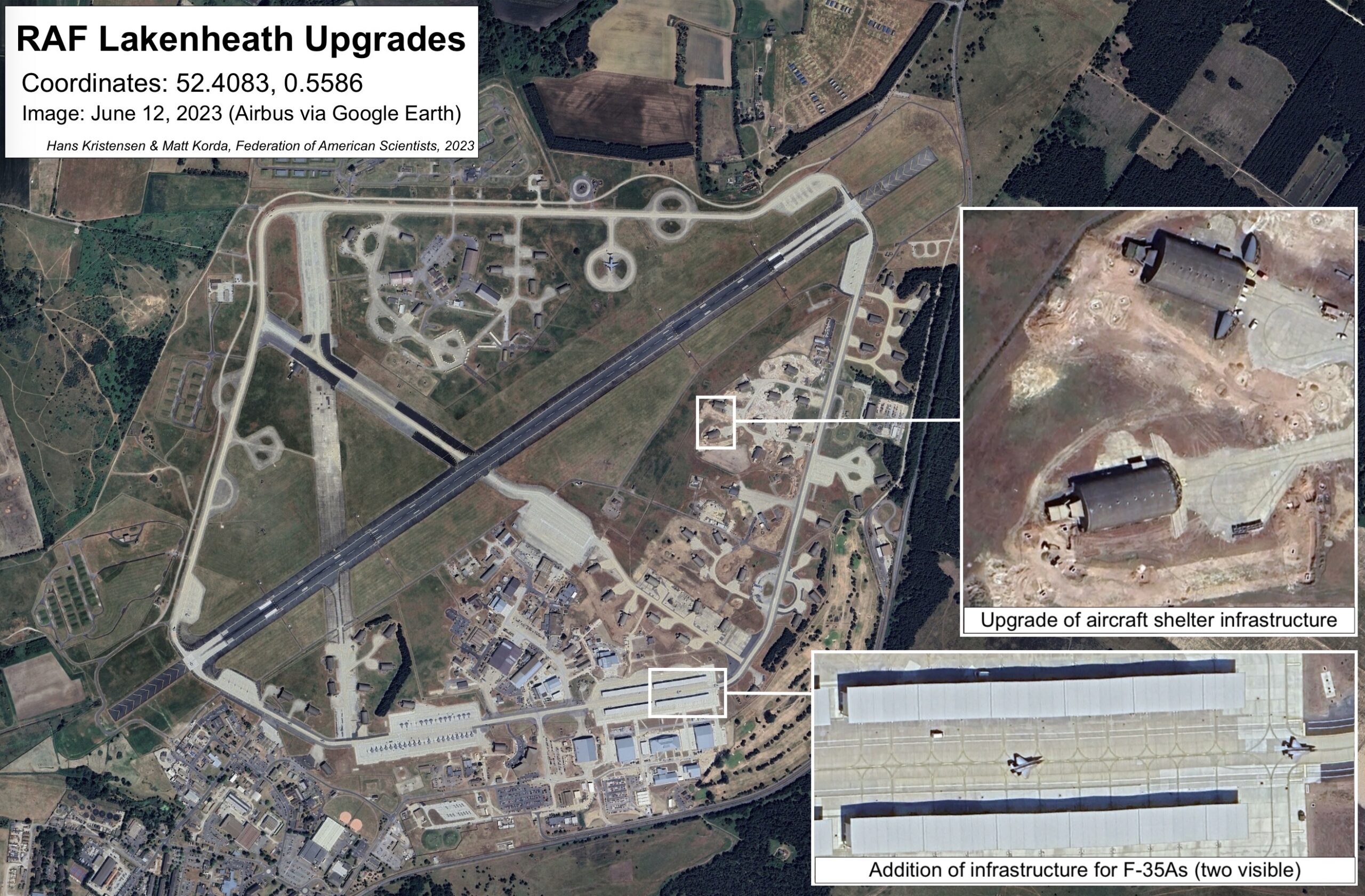
Significant modernization is underway at RAF Lakenheath for F-35A aircraft, a planned “surety dormitory,” and other infrastructure indicating that the nuclear weapons mission may be returning after a hiatus of 15 years.
New U.S. Air Force budgetary documents strongly imply that the United States Air Force is in the process of re-establishing its nuclear weapons mission on UK soil.
The Air Force’s FY 2024 budgetary justification package, dated March 2023, notes the planned construction of a “surety dormitory” at RAF Lakenheath, approximately 100 kilometers northeast of London. The “surety dormitory” was also briefly mentioned in the Department of Defense’s testimony to Congress in March 2023, but with no accompanying explanation. “Surety” is a term commonly used within the Department of Defense and Department of Energy to refer to the capability to keep nuclear weapons safe, secure, and under positive control.
The justification documents note the new requirement to “Construct a 144-bed dormitory to house the increase in enlisted personnel as the result of the potential Surety Mission” [emphasis added]. To justify the new construction, the documents note, “With the influx of airmen due to the arrival of the potential Surety mission and the bed down of the two F-35 squadrons there is a significant deficiency in the amount of unaccompanied housing available for E4s and below at Royal Air Force Lakenheath” [emphasis added].

The U.S. Air Force’s FY 2024 budgetary justification package describes the proposed construction of a “surety dormitory” at RAF Lakenheath.
Construction of the facility is scheduled to begin in June 2024 and end in February 2026.
We previously documented the UK’s addition to the Department of Defense’s FY2023 budgetary documentation for the NATO Security Investment Program, in which it was written that “NATO is wrapping up a thirteen-year, $384 million infrastructure investment program at storage sites in Belgium, Germany, the Netherlands, the UK, and Turkey to upgrade security measures, communication systems, and facilities” [emphasis added]. An explicit mention of the UK had not been included in the previous year’s budgetary documents, and it was removed in this year’s documents after we reported on its inclusion the previous year.

The removal of country names from the Pentagon’s latest list of nuclear base upgrades is yet another example of the United States reducing the nuclear transparency of its own nuclear posture while criticizing nuclear secrecy in other nuclear-armed countries.
The removal of country names from the Pentagon’s Military Construction Program budget request follows the denial of a recent FAS declassification request of previously available nuclear warhead numbers. These decisions contradict and undermine the Biden administration’s appeal for nuclear transparency in other nuclear-armed states.
The past two years of budgetary evidence strongly suggests that the United States is taking steps to re-establish its nuclear mission on UK soil. The United States has not stored nuclear weapons in the United Kingdom for the past 15 years, since we reported in 2008 that nuclear weapons had been withdrawn from RAF Lakenheath.
The Weapons Storage and Security Systems (known as WS3) at RAF Lakenheath are contained within Protective Aircraft Shelters; the WS3s include an elevator-drive vault that can be lowered into the concrete floor, as well as the associated command, control, and communications software needed to unlock the weapons. A total of 33 WS3 vaults were installed at RAF Lakenheath in the 1990s, each of which can hold up to four B61 bombs, for a maximum capacity of 132 warheads. Whenever nuclear weapons have been withdrawn from European air bases in the past, their vaults have been put into “caretaker” status, but as Harold Smith, the former U.S. Assistant Secretary of Defense for Nuclear, Chemical, and Biological Defense Programs stated at the time, these vaults were “mothballed in such a way that if we chose to go back into those bases we can do it.”
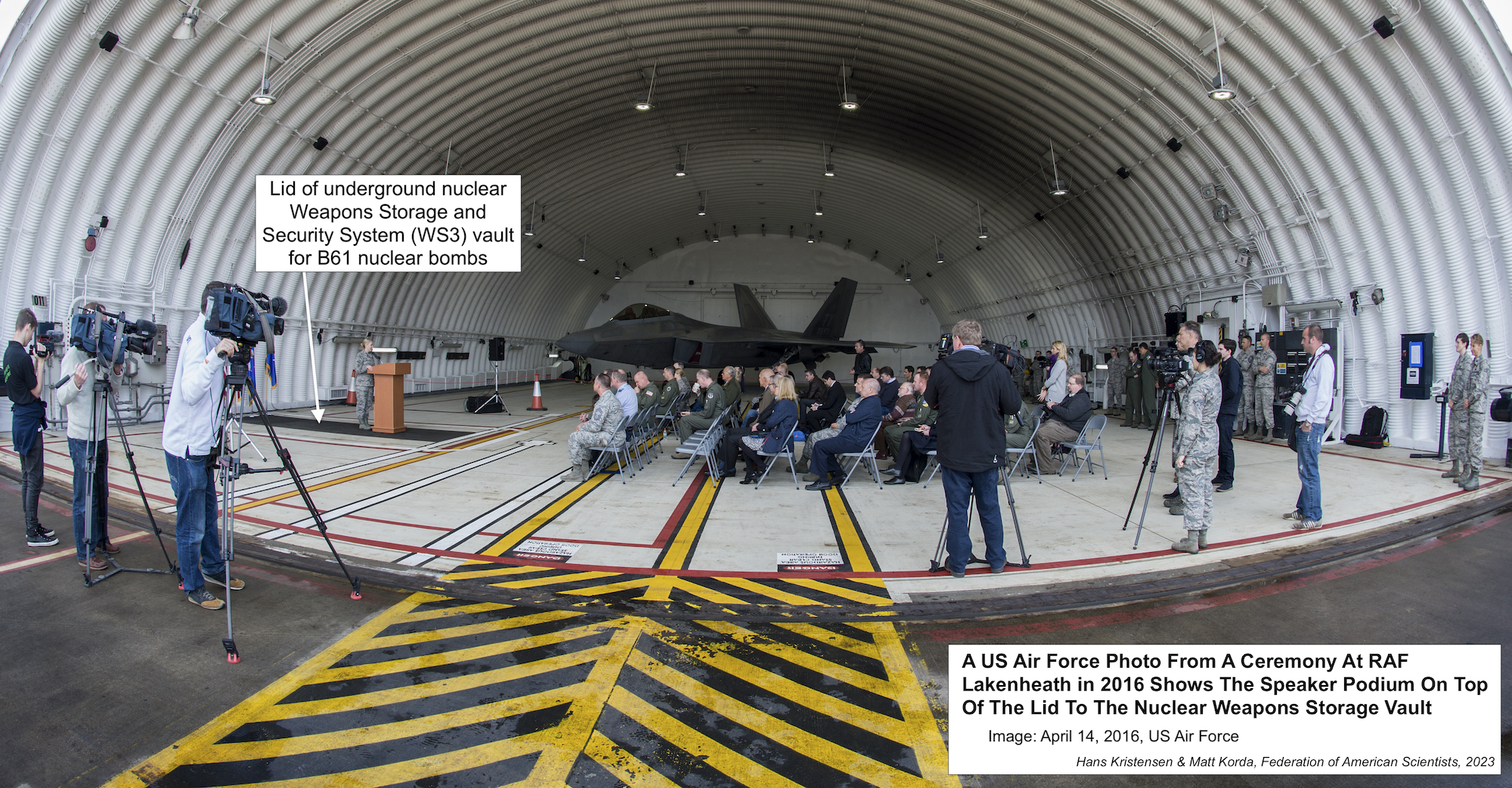
A total of 33 underground nuclear weapons storage vaults in aircraft shelters at RAF Lakenheath were mothballed, but documents indicate that they may be reactivated soon.
The nuclear-related upgrades to RAF Lakenheath are taking place as the new 495th Fighter Squadron (hosted at RAF Lakenheath) prepares to become the first U.S. Air Force squadron in Europe to be equipped with the nuclear-capable F-35A Lightning II. The upgrades coincide with the long-planned delivery of the new B61-12 gravity bombs to Europe, which will replace the approximately 100 legacy B61-3s and -4s currently estimated to be deployed in Europe.
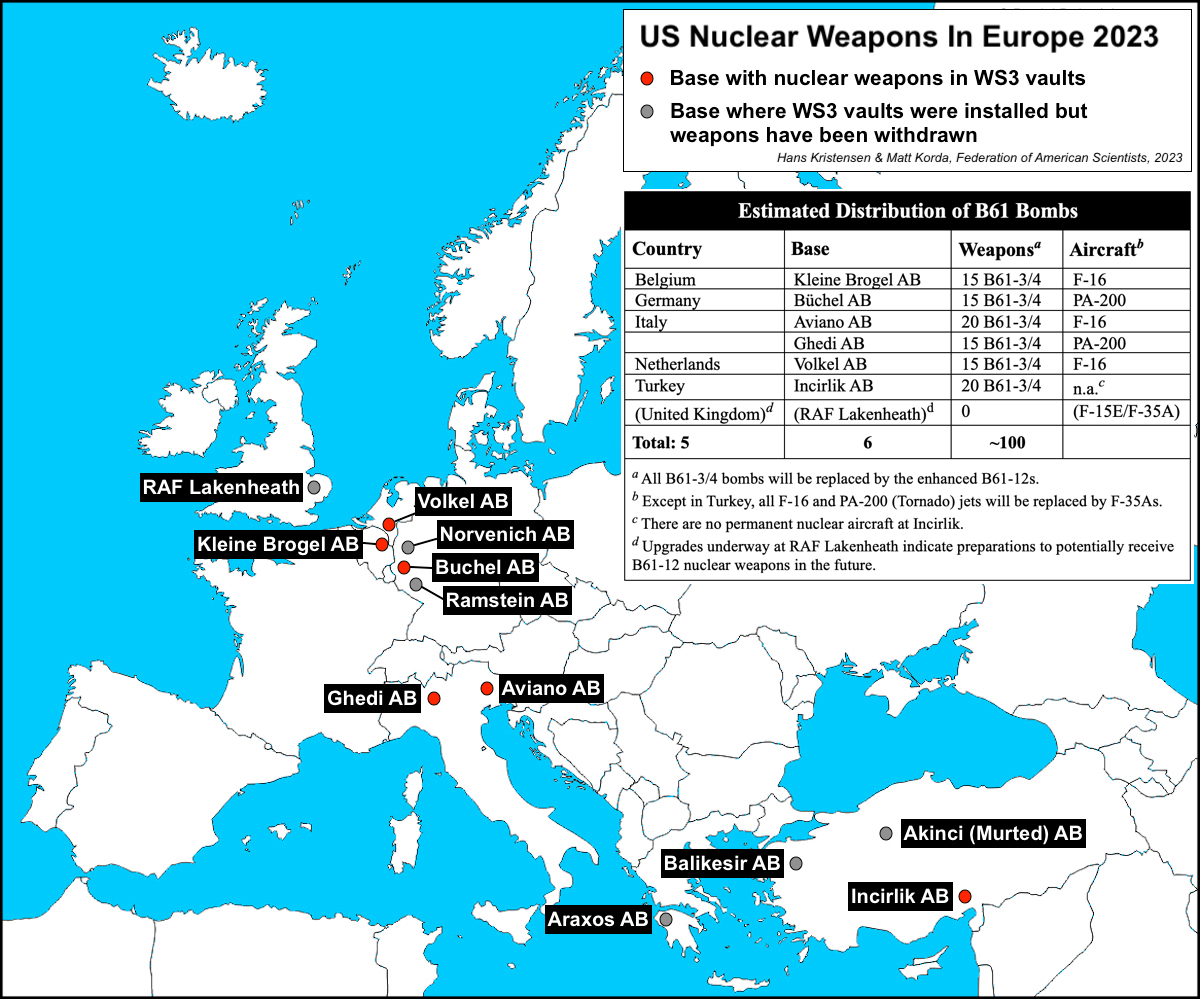
There are an estimated 100 B61 nuclear bombs deployed at six bases in five European countries, with preparations underway at RAF Lakenheath to potentially receive nuclear weapons as well.
In December 2021, in response to a media question about potentially stationing nuclear weapons in Poland, NATO Secretary General Jens Stoltenberg announced that “we have no plans of stationing any nuclear weapons in any other countries than we already have…” However, it is difficult to square his statement with the planned “arrival of the potential Surety mission” at RAF Lakenheath, as well as the addition of the base to the list of sites receiving nuclear upgrades.
One possible explanation is that the United States is currently preparing the infrastructure at RAF Lakenheath to allow the base to potentially receive nuclear weapons in the future or in the midst of a crisis, without necessarily having already decided to permanently station them there or increase the number of weapons currently stored in Europe. The budget language of a “potential Surety mission” indicates that a formal deployment decision has not yet been made.
This would be consistent with construction at other known nuclear storage bases across Europe, where new upgrades are taking place that are designed to facilitate the rapid movement of weapons on- and off-base to increase operational flexibility. In the midst of a genuine nuclear crisis with Russia, for example, a portion of U.S. nuclear weapons could be redistributed from more vulnerable eastern bases to RAF Lakenheath.
Background information:
Lakenheath Air Base Added To Nuclear Weapons Storage Site Upgrades
NATO Steadfast Noon Exercise and Nuclear Modernization in Europe
The C-17A Has Been Cleared To Transport B61-12 Nuclear Bomb To Europe
FAS Nuclear Notebook: US nuclear weapons, 2023
This research was carried out with generous contributions from the John D. and Catherine T. MacArthur Foundation, the New-Land Foundation, the Ploughshares Fund, the Prospect Hill Foundation, Longview Philanthropy, the Stewart R. Mott Foundation, the Future of Life Institute, Open Philanthropy, and individual donors.
While Advocating Nuclear Transparency Abroad, Biden Administration Limits It At Home
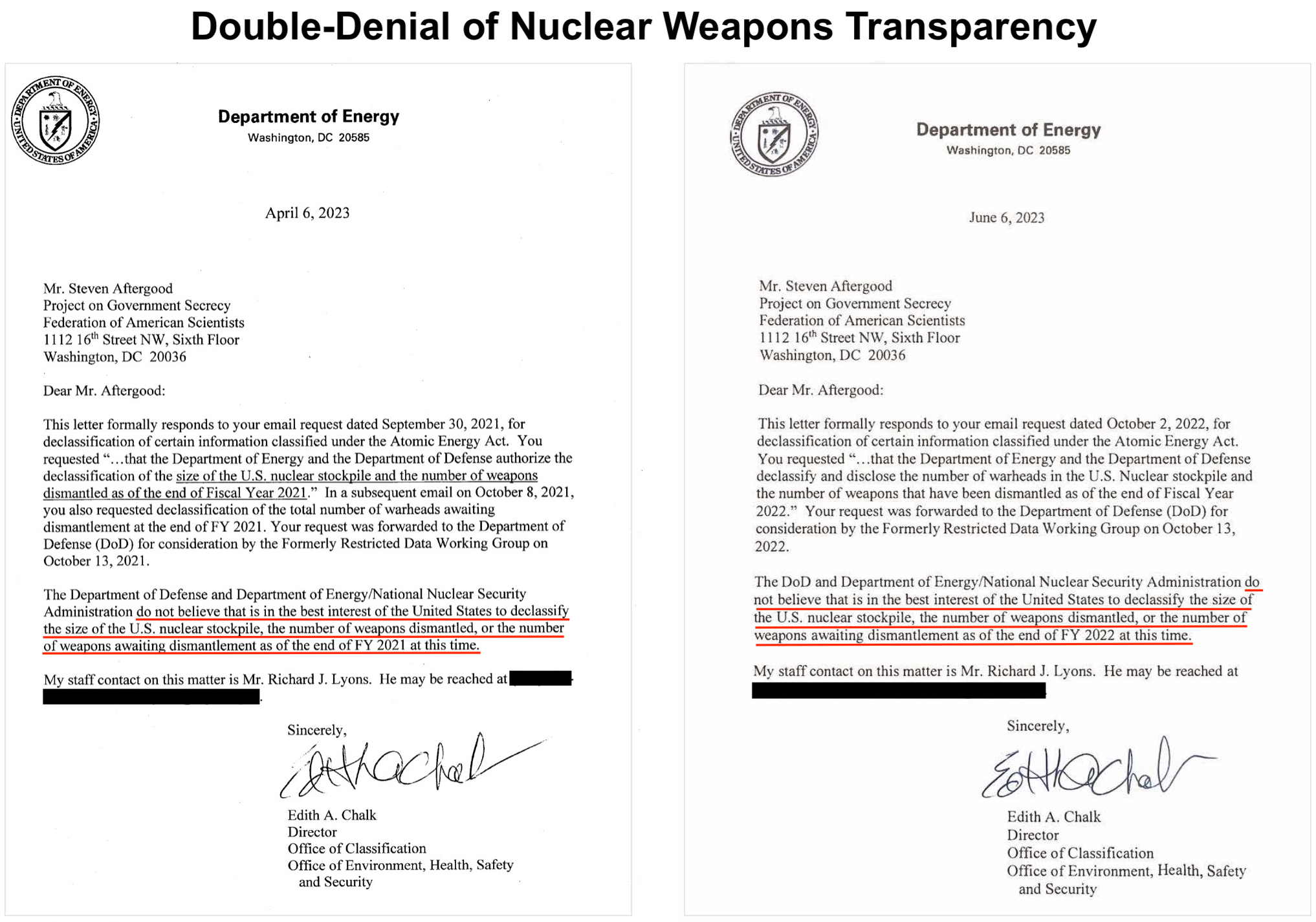
While US diplomats were busy advocating nuclear transparency abroad, the Department of Defense and Department of Energy rejected two requests from the Federation of American Scientists to declassify nuclear weapons stockpile and dismantlement numbers.
This week, US diplomats will join colleagues in Vienna from 189 other countries for the first session of the Preparatory Committee for the 2026 Review Conference of the nuclear Non-Proliferation Treaty (NPT).
At the meeting, the US diplomats are expected to speak in favor of nuclear transparency and criticize some other nuclear-armed states for not being transparent enough about their nuclear arsenal. They are right in doing so because nuclear transparency is important for international security and democratic values.
Unfortunately, the diplomats’ efforts are undermined by other elements of the US administration that are reducing transparency of the US nuclear arsenal.
Earlier this spring, the Department of Defense and Department of Energy twice rejected requests from the Federation of American Scientists to declassify the number of nuclear weapons in the US stockpile and the number of nuclear weapons awaiting dismantlement. The requests (see copies above) were made by Stephen Aftergood who until 2021 directed the FAS project on government secrecy.
Contradicting Previous Policies
The rejections of FAS’ declassification requests are noteworthy because the US government in previous years repeatedly has declassified and released such information to the public. In 1994, the US Department of Energy declassified the stockpile size and other information between 1945 and 1994. In 2010, the Obama administration declassified the entire remaining history of US nuclear weapons stockpile as well as warheads dismantled since 1994. These disclosures continued in subsequent years and even expanded to include the number of weapons awaiting dismantlement.
When the Trump administration took office, it soon closed the door on transparency and kept it shut for three years. But after Joe Biden won the presidential election, his administration in October 2021 restored stockpile transparency by declassifying the number as of September 2020. An announcement on the National Nuclear Security Administration’s web site states:
“Increasing the transparency of states’ nuclear stockpiles is important to nonproliferation and disarmament efforts, including commitments under the Nuclear Non-Proliferation Treaty, and efforts to address all types of nuclear weapons, including deployed and nondeployed, and strategic and non-strategic.”
Then, in a curious decision in 2022, the Biden administration discontinued its own nuclear transparency policy. It was expected that Secretary of State Antony Blinken would use his speech to the NPT Review Conference in August 2022 to announce the September 2021 stockpile number. Instead, he mentioned a vague percentage reduction since 1967. The political rationale was probably a reaction to Russia’ invasion of Ukraine.
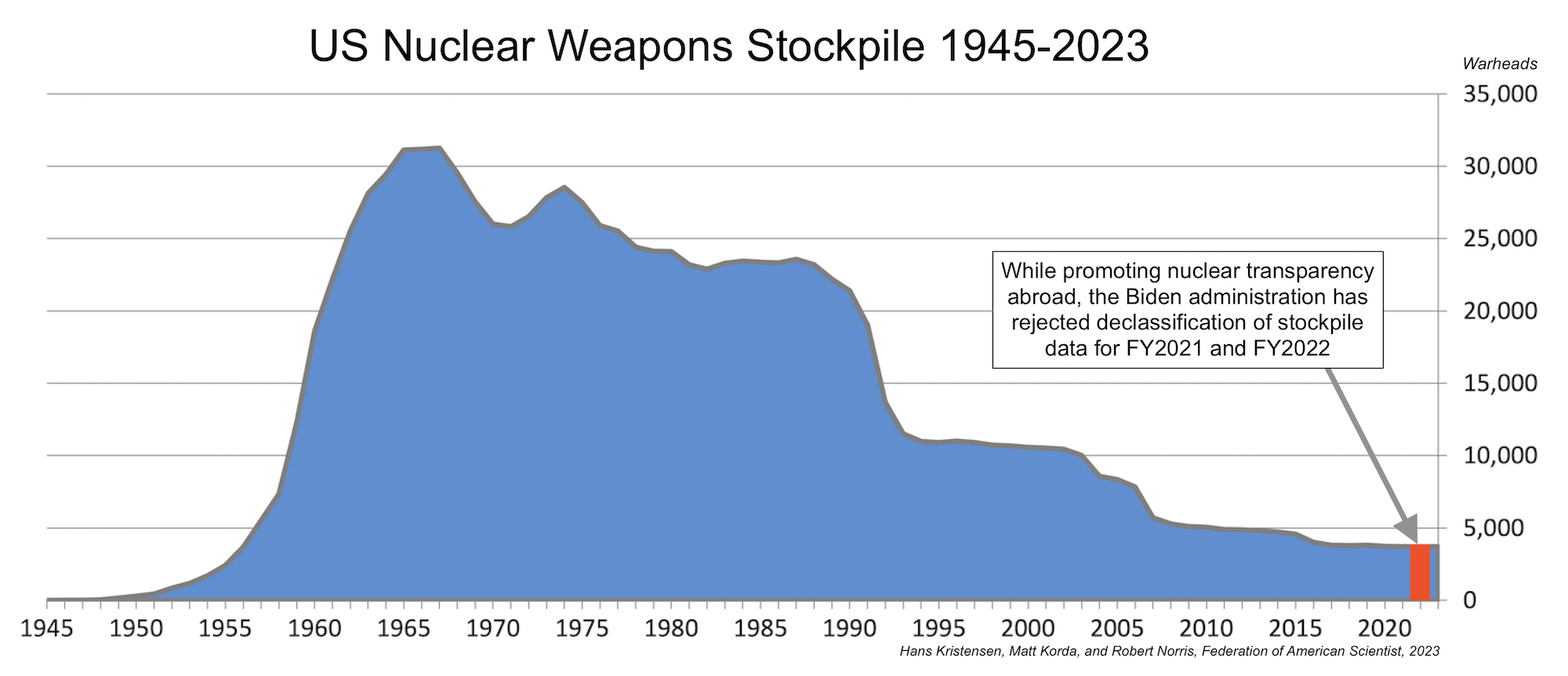
The history of size of the US nuclear weapons stockpile has been declassified and released to the public, except for the two latest years that the Biden administration is keeping secret. We estimate that the stockpile currently includes approximately 3,700 warheads.
Declining Transparency
Compared to other nuclear-armed states, the United States is generally more transparent about its nuclear arsenal, strategy, and policies and has been so for a long time. So the Biden administration’s recent backpedaling on warhead stockpile transparency is unusual but only the latest in a series of steps by nuclear-armed states that have reduced transparency of nuclear arsenals and operations. The trend is that four of the world’s nine nuclear-armed states are decreasing nuclear transparency, including the United States and Britain who recently have taken steps to reduce information about their nuclear arsenals (see below).
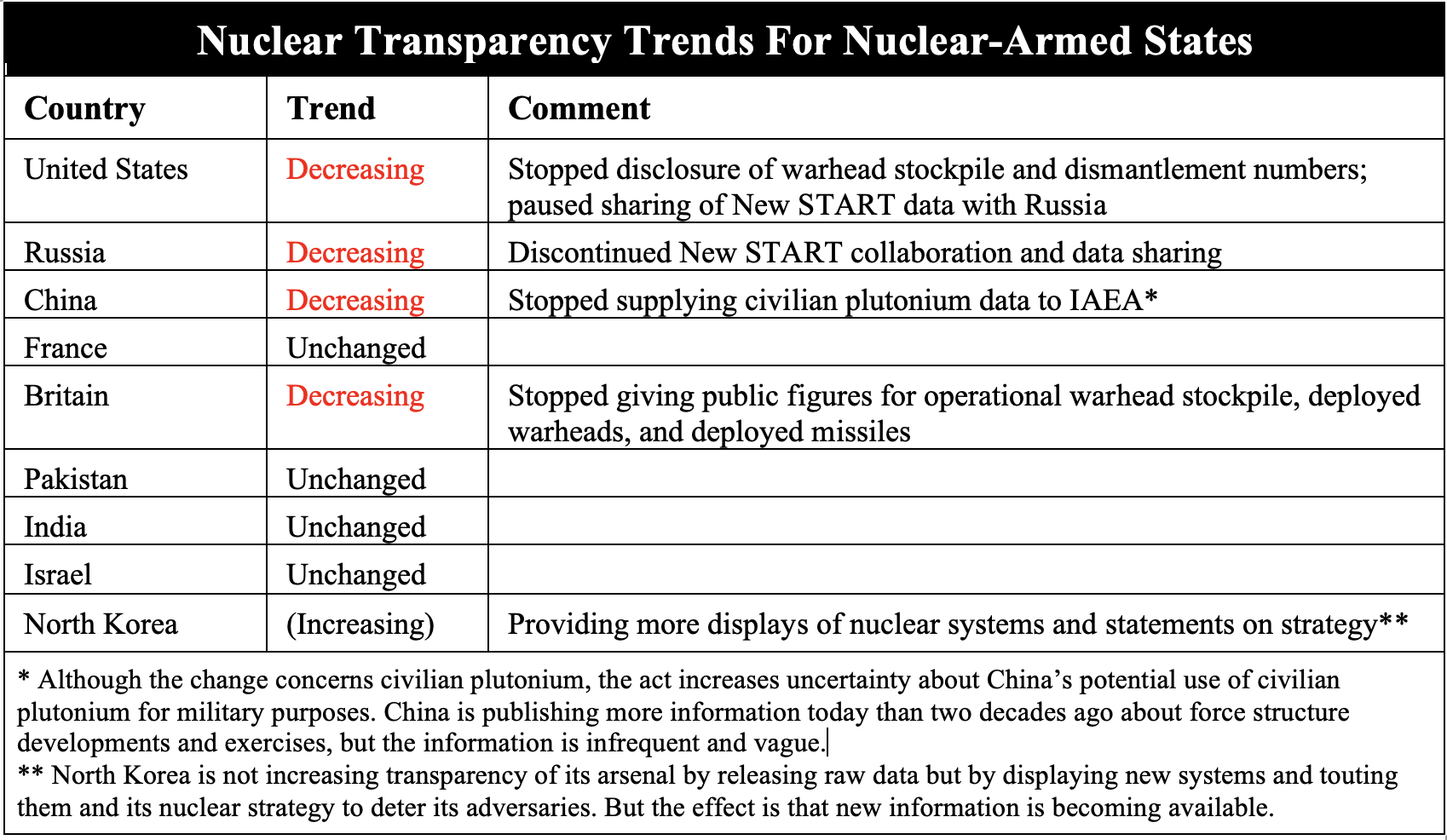
The global trend is that the nuclear-armed states are decreasing the transparency of their nuclear arsenals, including countries that are otherwise saying transparency is important.
Ironically, North Korea is the only country that can be said in some sense to be increasing transparency, although not by providing raw data but by touting new weapons and strategy that as a result provide some additional information.
Lack of and decreasing nuclear transparency increase uncertainty and suspicion and can cause other countries to increase reliance on worst-case scenarios and even make mistakes about the intensions and plans of other nuclear-armed countries. Moreover, lack of and decreasing transparency leave the public debate open for exaggerations and false rumors.
Secrecy and defense hawks often argue that the United States should not release such information when its adversaries don’t. But nuclear transparency is not a gift to adversaries but a norm that nuclear-armed states should continue to promote and uphold for international and democratic reasons. And if countries say it is important, they should act accordingly.
Undercutting Diplomacy and Democracy
The rejections of FAS’ requests for declassification of nuclear warhead stockpile and dismantlement numbers have direct implications for US diplomacy because they contradict the nuclear transparency values that US diplomats are promoting overseas (including this week in Vienna), undercut US critique of Russian and Chinese nuclear secrecy, and make the United States look hypocritical.
In May this year, right between the two rejections of FAS’ declassification requests, the United States together with the other G7 countries at the Hiroshima Summit publicly emphasized the importance of nuclear transparency, including the size of their nuclear arsenals:
“We emphasize the importance of transparency with regard to nuclear weapons and welcome actions already taken by the United States, France and the United Kingdom to promote effective and responsible transparency measures through providing data on their nuclear forces and the objective size of their nuclear arsenal.”
Instead, and apparently as a direct consequence of the rejections of FAS’ declassification requests, when US Ambassador Bruce Turner spoke at the special nuclear transparency session in the Conference on Disarmament in June 6th (the very same day DOD and DOE rejected FAS’ declassification request for 2022 stockpile data), he was unable to present the delegates with updated information to demonstrate the US continued commitment to transparency but instead had to repeat old data from 2020.
In addition to undercutting US diplomatic efforts and credibility abroad, the declassification rejections also conflict with democratic values at home by depriving the US public official factual information it needs to be able to monitor how the government is managing the nuclear arsenal and warhead dismantlements – not to mention whether what the administration says abroad matches what it does at home. Factual information is essential to ensure voters can make informed decisions about government policy.
The extensive declassifications of stockpile and dismantlement numbers in previous years clearly demonstrate that such information is not secret, and that the government has no legitimate reason to withhold it from the public – other than it doesn’t want to “at this time.”
FAS believes the Biden administration’s decision to deny declassification of the nuclear weapons stockpile data for 2021 and 2022 is wrong, self-contradictory, and counterproductive and urges the White House to review the decision to restore US nuclear transparency so its diplomats can credibly promote this important norm abroad.
Additional information:
• Nuclear Notebook: United States Nuclear Weapons, 2023
• Increased Nuclear Secrecy Makes Us All Less Safe
• Status of World Nuclear Forces
This research was carried out with generous contributions from the John D. and Catherine T. MacArthur Foundation, the New-Land Foundation, Ploughshares Fund, the Prospect Hill Foundation, Longview Philanthropy, the Stewart R. Mott Foundation, the Future of Life Institute, Open Philanthropy, and individual donors.
Belarus’ “Nuclear-Capable” Iskanders Get A New Garage
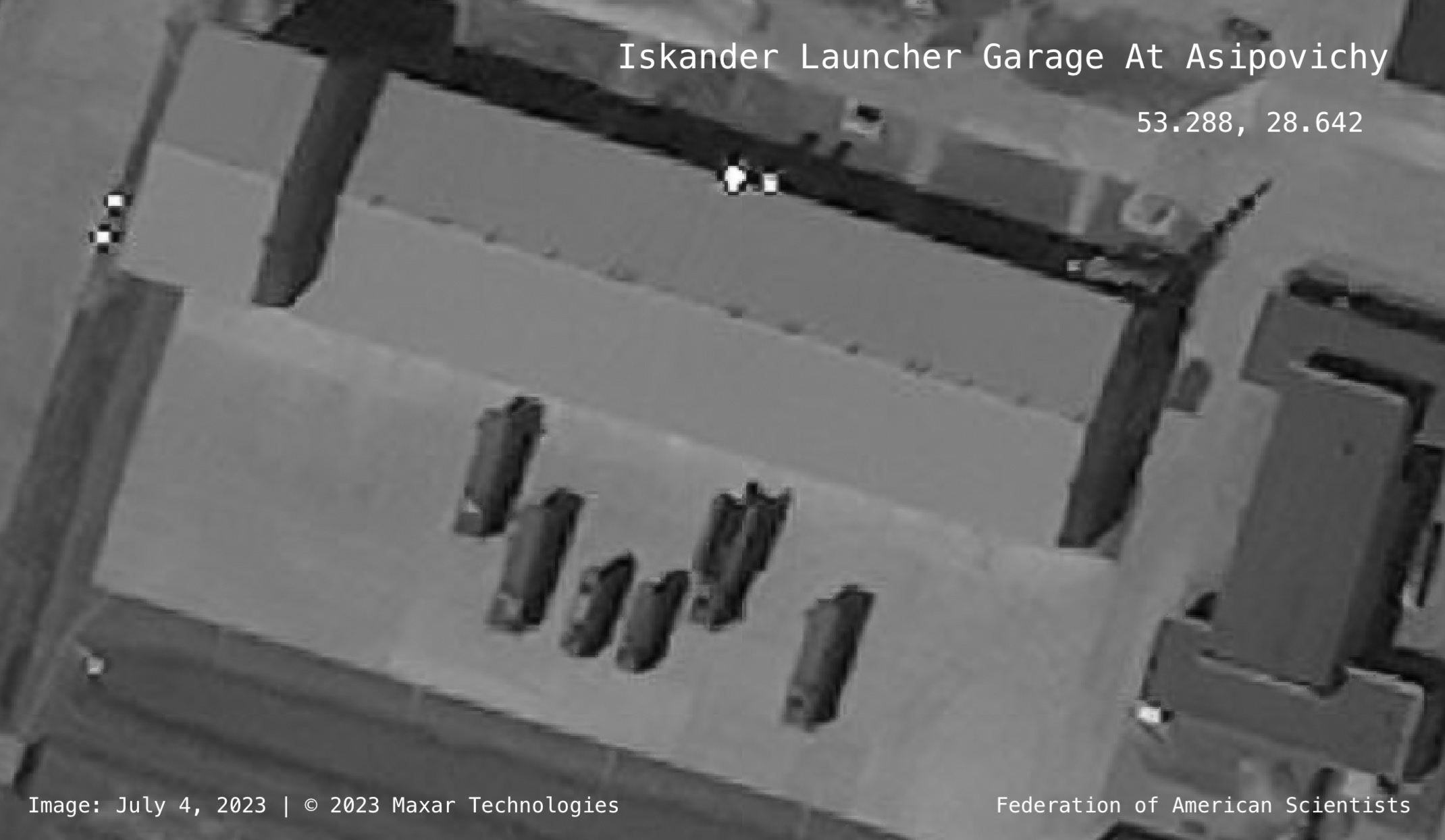
A Maxar satellite image appears to show Iskander missile launchers outside new garage at Belarusian base
The Belarusian military has completed what appears to be a new garage facility for the allegedly nuclear-capable Iskander missile launchers it received from Russia.
The new facility was added to an existing base in Asipovichy in central Belarus (53.288, 28.642), which is home to the 465th Missile Brigade. Satellite images indicate construction began in October 2022 and was completed in April 2023.
A Maxar satellite image taken on July 4, 2023, shows what appears to show four 13-meter Iskander launchers (and/or transporters) and two smaller support vehicles outside the garage. The missile storage compartment on one of the launchers is open.
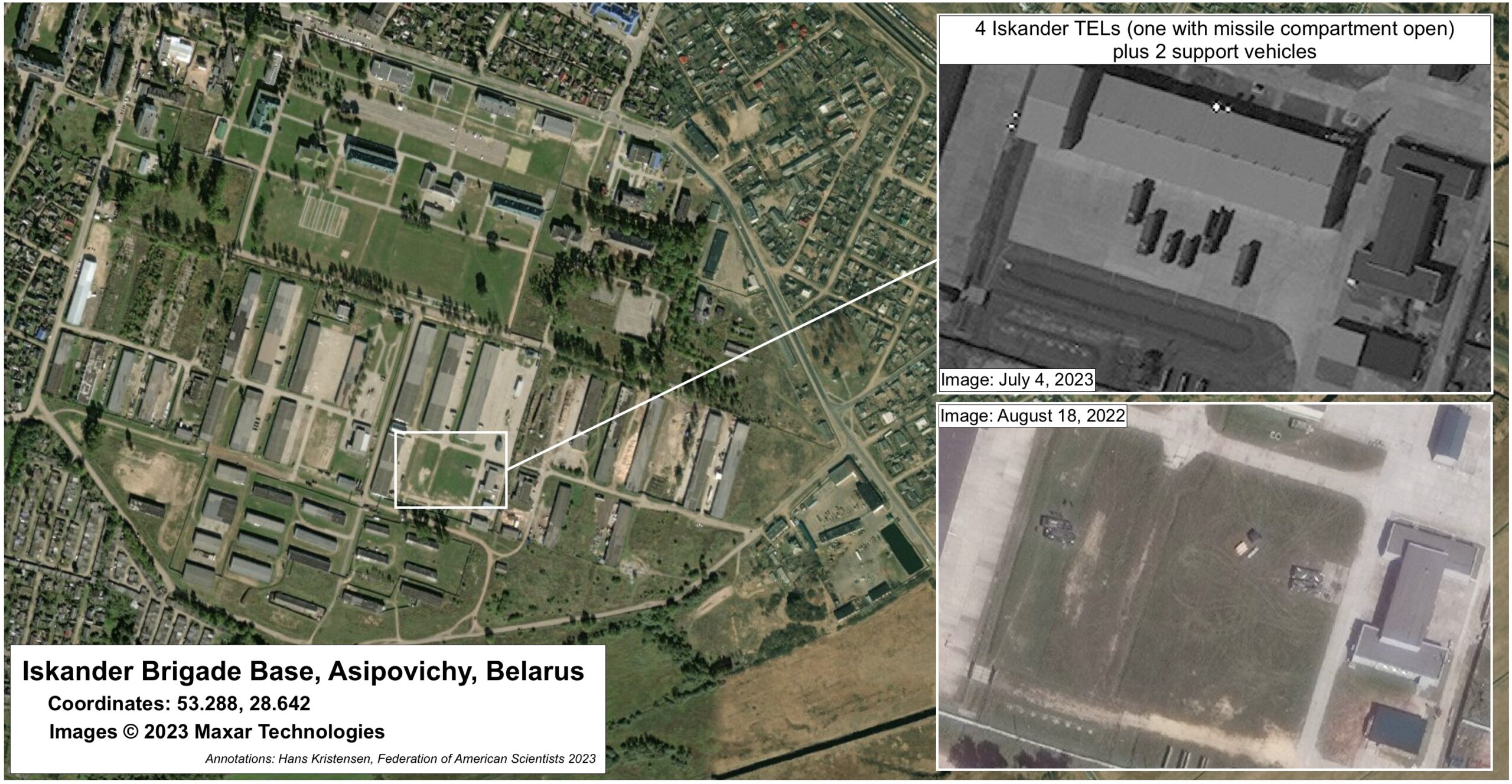
Between October 2022 and April 2023, a new Iskander garage was constructed at a Belarusian military base in Asipovichy
The new facility is located only seven kilometers (4.4 miles) from the training ground (53.296, 28.536) where the Iskander launchers were first geolocated, and only 12 kilometers (7.3 miles) from a weapons depot (53.317, 28.813) that might be undergoing a potential upgrade to a temporary nuclear warhead storage facility.
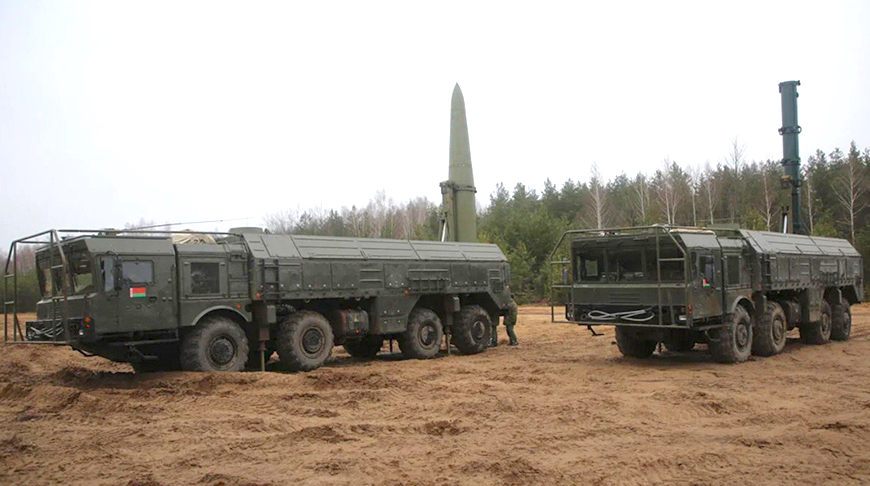
Russian Iskander missile launchers supplied to Belarus allegedly are capable of firing Russian nuclear warheads
Belarusian President Alexander Lukashenko and Russian President Vladimir Putin have repeatedly described plans to equip Belarusian Iskander launchers with the capability to fire Russian nuclear-tipped missiles and to build a nuclear storage facility in Belarus. They also said Russia would upgrade some Belarusian military jets (potentially Su-24 or Su-25) to deliver nuclear bombs.
If so, this would be the first time since the Cold War that Russia is equipping another country to launch its nuclear weapons and undercut Russian criticism of U.S. nuclear sharing arrangements with NATO allies.
So far there has been no clear visual confirmation of these plans, and public Western intelligence reports have not confirmed that Russia has actually deployed nuclear warheads in Belarus. Russia is thought to keep its non-strategic nuclear warheads in central storage facilities in Russia.
Additional information:
• Russian Nuclear Weapons Deployment Plans In Belarus: Is There Visual Confirmation?
• Video Indicates That Lida Air Base Might Get Russian “Nuclear Sharing” Mission In Belarus
• Nuclear Notebook: Russian Nuclear Weapons, 2023
This research was carried out with generous contributions from the John D. and Catherine T. MacArthur Foundation, the New-Land Foundation, Ploughshares Fund, the Prospect Hill Foundation, Longview Philanthropy, the Stewart R. Mott Foundation, the Future of Life Institute, Open Philanthropy, and individual donors.
Oppenheimer, FAS, and Today’s Nuclear Weapons Risks
They won’t fear it unless they understand it. And they won’t understand it until we use it
– Cillian Murphy, depicting J. Robert Oppenheimer, in Oppenheimer, opening in theaters tomorrow.
The anticipated summer blockbuster is already abuzz with its portrayal of history, politics, ethics, and science; for good measure, it’s said to have “earned that R rating” for the undisclosed “complicated” sexual appetites of the main characters, too.
What may truly stun audiences, though, is the realization of what has and hasn’t changed when it comes to nuclear weapons risks – especially now.
Oppenheimer and FAS
Audiences will be interested to learn of Oppenheimer’s connection to the Federation of American Scientists (FAS). His work actually created FAS in 1945. Initially called the Federation of Atomic Scientists, a group of scientists directly involved with the Manhattan Project formed FAS in response to the urgent need to combat nuclear arms racing by promoting public engagement, reducing nuclear risks, and establishing an international system for nuclear control and cooperation. This is a mission we continue today.
FAS has come to Oppenheimer’s defense not once, but twice. First, in 1954, by joining forces with Albert Einstein and scientists from Princeton to defend Oppenheimer’s loyalty and patriotic devotion to the United States when the government revoked his security clearance, stripping him of his stature and ability to serve in high levels of the government. Second, in 2022, FAS submitted a formal letter of support when the government retroactively and posthumously restored Oppenheimer’s reputation.
FAS continues to be a leader in promoting nuclear arms control, nonproliferation, and disarmament through our Nuclear Information Project. By providing the most accurate information about nuclear weapons and trends to policymakers, activists, academics, journalists, and the public, we strive to create the conditions for a more just, equitable, and peaceful world. We also recognize the importance of training and empowering the next generation of nuclear arms controllers and policy experts. To that end, FAS is currently fostering new perspectives via our New Voices in Nuclear Weapons fellowship. Still, more work is needed.
I spoke with Eliana Johns, Research Associate with the Nuclear Information Project at FAS, about how Oppenheimer’s story connects with contemporary issues and current risks, and how FAS continues to advocate for a safer world.
Katie: What would you say to someone who sees Oppenheimer and comes away from it with a new sense of awe, and perhaps dread, about nuclear capabilities? Audiences may be profoundly upset to realize nuclear weapons are still a threat. What are some misconceptions people may have about threat levels today?
Eliana: I think Oppenheimer will definitely be a lot for everyone to process. The film may even be the first moment that people (especially from my generation) realize the destructive capability of nuclear weapons and that the threat of nuclear use is still very real today. There are plenty of misconceptions about the technical aspects, the purpose, and the costs associated with nuclear weapons programs. For instance, we all know about the devastating bombings of Hiroshima and Nagasaki in 1945, but some may not know that modern nuclear warheads and delivery systems are exponentially more powerful and accurate. However, I think the biggest misconception is that nuclear weapons don’t cause any harm unless used in war.
I think the biggest misconception is that nuclear weapons don’t cause any harm unless used in war.
Katie: What are some issues the film will likely misunderstand, gloss over, or even avoid?
Unfortunately, the film will likely leave out a huge part of the story of the Manhattan Project: impacted communities. From predominantly Navajo uranium miners in Colorado and Congolese miners in the Belgian Congo to downwinders and victims of nuclear testing in the southwestern United States, Kazakhstan, the Marshall Islands, and Algeria to the Hibakusha in Japan – nuclear weapons have already taken a toll on countless communities around the world. Not only is the threat of further nuclear weapons use very real today, but many other consequences have already resulted from their invention, testing, and use.
Additionally, nuclear weapons programs are expensive, which means that countries like the United States end up spending billions of dollars each year on maintaining and modernizing their nuclear arsenals, while countries like North Korea resort to hacking, laundering, exploitation, and other illegal activities to fund their nuclear weapons and missile programs. The cumulative costs are tremendous and put a huge burden on the public.
Although it can be hard and confusing, having conversations about nuclear weapons is important because we cannot ignore the problem. We should feel some level of dread and anger because nuclear weapons are dangerous and have already had significant and terrible impacts on many people’s lives. In a time when nuclear weapons are being referenced more and more in the news, social media, and politics, I hope seeing Oppenheimer will inspire people to become more informed and engaged on these issues.
Katie: What is being done today to mitigate nuclear risks, and what is the role of FAS in this work?
Eliana: There are a variety of ways that people work to mitigate the risk of nuclear weapons use and seek justice for those impacted by nuclear testing and uranium mining. From academics to government officials, people are working toward arms control and non-proliferation goals to prevent the increase and spread of nuclear weapons. Also, several organizations (such as the Tularosa Basin Downwinder Consortium) advocate for downwinder communities, seek financial and environmental reconciliation, and tell their stories.
A crucial aspect of this work is transparency. When governments are opaque about how many weapons they have and the situations in which they might use them, this causes arms racing and worst-case thinking between nations that are in blind competition with one another. And when governments are not transparent with their citizens about nuclear-related accidents, exposure, or spending on weapons systems, people suffer the consequences.
Because of this key element of transparency, our work at FAS is extremely important. FAS’ Nuclear Information Project develops estimates of global nuclear weapons stockpiles in order to inform conversations around arms control and risk reduction in both the public and private sectors. Our goal is to engage the public and policymakers in educated discussions about topics such as nuclear weapons spending, non-proliferation, and the intersectionality between nuclear weapons and other security threats like climate change. This work continues the long-lasting legacy of promoting transparency and accountability in the nuclear weapons space, which is vital for progress in reducing the risks of nuclear weapons.
FAS also recently started a summer program for aspiring nuclear weapons experts called the New Voices on Nuclear Weapons Fellowship. This program is designed to address the high barriers to entry into the nuclear field by providing young nuclear scholars with support, mentorship, and opportunity for publication. Programs such as this help bring up the next generation of experts who carry with them a diverse range of experiences and perspectives that inform creative ideas for the future of arms control and non-proliferation.
Katie: What should the general public do to learn more, stay informed, and join the effort to reduce reliance on nuclear weapons?
Eliana: FAS is a great place to stay updated on what is happening in the world with regard to nuclear weapons. The Nuclear Information Project team publishes detailed accounts of the current status of nuclear weapons arsenals as well as shorter, factual articles that explain important events or discoveries.
Many other organizations in the nuclear policy field are also working to inform and engage people on these issues and offer a variety of resources that can be easily shared with friends, coworkers, and family members; many also provide information on how to engage with your representatives. For example, The Friends Committee on National Legislation helps you contact your members of Congress about issues like extending the Radiation Exposure Compensation Act (RECA), which provides monetary benefits to onsite participants of nuclear testing and downwinders but is set to expire in 2024.
After watching Oppenheimer (in IMAX 70mm, of course), I hope folks will be inspired to learn more about the nuclear field and use these resources to take part in the effort to stigmatize nuclear weapons and seek justice for impacted communities.
Katie: Well said! Thank you for your time, Eliana.
Nuclear Notebook: French Nuclear Weapons, 2023
The FAS Nuclear Notebook is one of the most widely sourced reference materials worldwide for reliable information about the status of nuclear weapons and has been published in the Bulletin of the Atomic Scientists since 1987. The Nuclear Notebook is researched and written by the staff of the Federation of American Scientists’ Nuclear Information Project: Director Hans M. Kristensen, Senior Research Fellow Matt Korda, and Research Associate Eliana Johns.
This issue’s column reviews the status of France’s nuclear arsenal and finds that the stockpile of approximately 290 warheads has remained stable in recent years. However, significant modernizations regarding ballistic missiles, cruise missiles, submarines, aircraft, and the nuclear industrial complex are underway.
Read the full “French Nuclear Weapons, 2023” Nuclear Notebook in the Bulletin of the Atomic Scientists, or download a PDF using the button on the left side of this page. The complete archive of FAS Nuclear Notebooks can be found here.
Does Russia Have Nuclear Landmines?
Photos of Russian nuclear “backpacks” or landmines are hard to come by. For illustrative purposes, this is an image of a U.S. Special Atomic Demolition Munition (SADM) in its bag (since retired). The U.S. military possessed nuclear demolition weapons until the 1980s.
Last week, Reuters published a report that said the Wagner group rebellion that sent armed forces hundreds of miles across Russia got near a nuclear weapons storage site: Voronezh-45.
Kyrylo Budanov, the head of Ukraine’s military intelligence, reportedly said that the rebels reached the nuclear base and that their intention was to acquire small Soviet-era nuclear devices in order to “raise the stakes” in their mutiny.
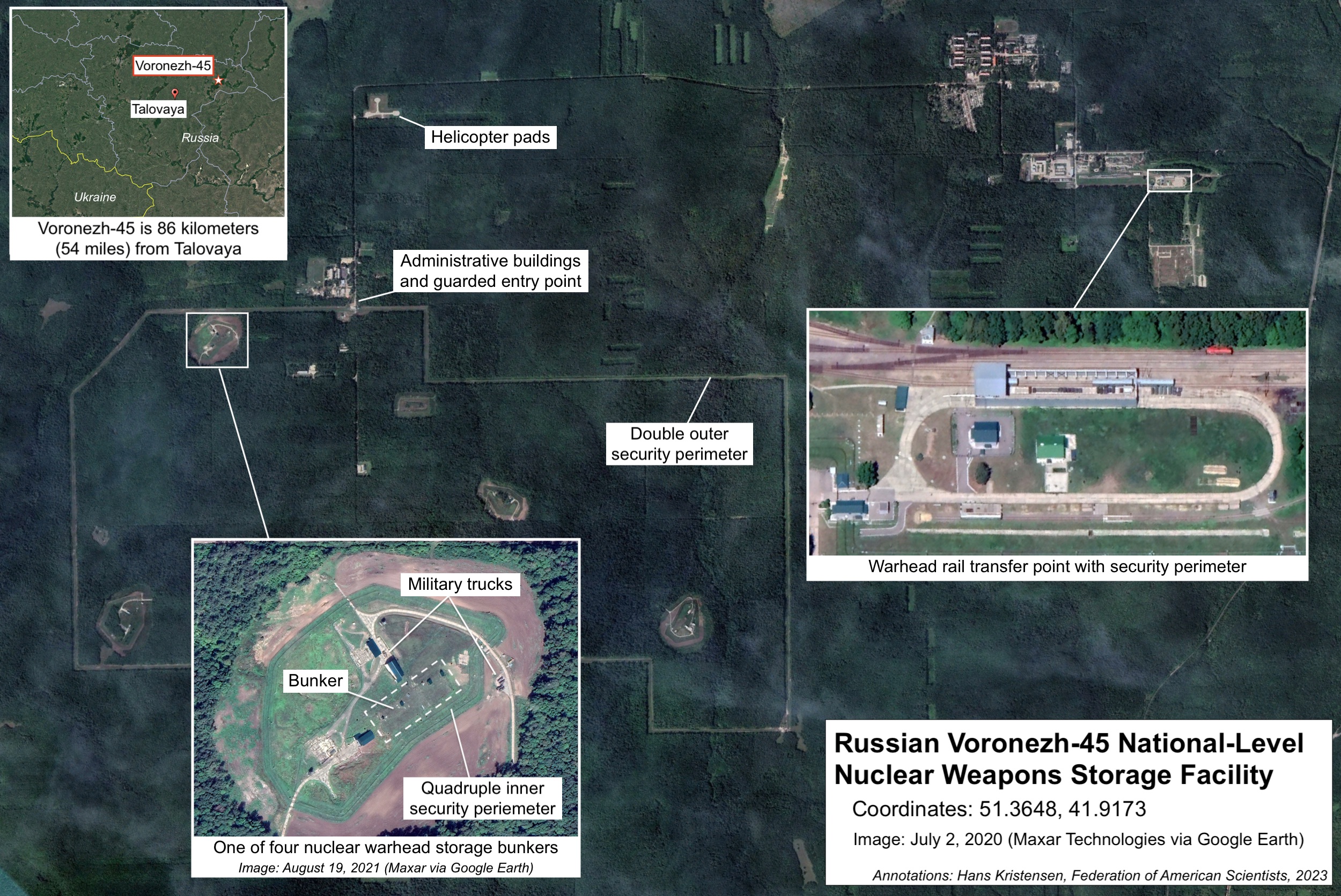
Wagner rebels approached a Russian nuclear weapons storage site near Voronezh to get nuclear “backpacks,” Ukraine’s military intelligence chief claimed. The White House said it could not corroborate the claim.
A White House spokesperson said he could not corroborate the report and added that the United States “had no indication at any point that nuclear weapons or materials were at risk” during the Wagner event.
To help improve transparency on this issue, below we review what U.S. and NATO sources have stated recently about Russian nuclear landmines and non-strategic nuclear forces in general (for a more detailed overview of Russian nuclear forces, see our latest Nuclear Notebook).
Western Statements About Russian Nuclear Landmines
Whether or not the Wagner rebels got to or near a Russian nuclear weapons storage site (or what their intensions were), or whether nuclear weapons potentially stored there were at risk, the episode raises the question if Russia still has nuclear “backpacks” or landmines?
The answer appears to be yes – at least in some form. Recent U.S. Intelligence Community reports refer to them repeatedly, including a U.S. State Department report from 2023. But it is unclear what the status of the Russian landmines is: Are they part of the operational forces or leftovers from the Cold War in queue for dismantlement?
Before examining that question, it is useful to first review what U.S. and NATO sources have said about Russian landmines.
Refences to Soviet-era nuclear landmines can be found in many declassified Intelligence reports. One Central Intelligence Agency assessment from 1981 reported that the Soviet Union “may have introduced nuclear landmines” and a Defense Intelligence Agency guide reportedly listed them. But the wording in these reports were “may have” or “possibly have,” indicating a lower level of confidence. When the Soviet Union broke apart, the issue of “loose nukes” became a prominent concern – especially small weapons that could be easily transported. In a speech at the Stimson Center in 1994, for example, then US Defense Secretary William Perry expressed concern about the danger of loose tactical nuclear weapons in Russia, “such as nuclear artillery shells, land mines and others.” In 1997, Alexander Lebed, a former Russian general and advisor who had been fired by President Yeltsin, claimed Russia had lost track of 100 of 250 suitcase nuclear bombs. The U.S. Government and others questioned the claim and Lebed later withdrew his claim.
These were extraordinary claim for which no evidence was provided and Lebed later withdrew his claim. Yet the rumor that Russia has nuclear landmines has continued to percolate in the public debate and studies. The Trump administration’s Nuclear Posture Review from February 2018 did not list landmines in its overview of Russian non-strategic nuclear weapons. But the following year, one Pentagon official told Congress that the Russian non-strategic nuclear arsenal included “nuclear landmines, and nuclear artillery shells…” NATO appeared to pick up on that in its Annual Report from 2020 that listed both “landmines” and “artillery” (see image below). (It should be noted that neither the U.S. Department of State’s 2022 compliance report nor its 2023 non-strategic nuclear weapons report mentions nuclear artillery.)
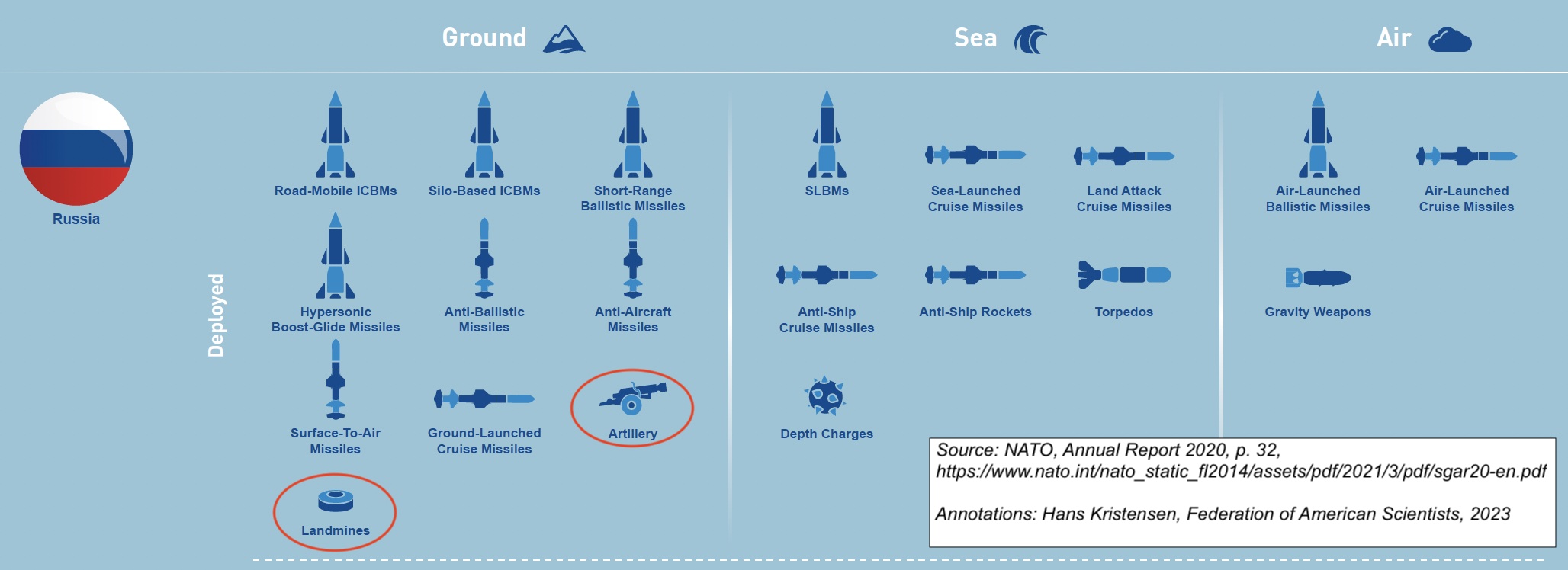
NATO in 2020 listed both landmines and artillery in its overview of Russian nuclear forces.
References to Russian nuclear landmines have also appeared frequently in the U.S. State Department’s annual reports on arms control compliance. The report from 2020 listed “atomic demolition mines” as part of Russia’s “active” stockpile of non-strategic nuclear weapons. The 2021 report did not explicitly mention nuclear mines in the active stockpile, and the 2022 report changed the language slightly to the active stockpile “has also continue to include nuclear mines.”
The latest compliance report from 2023 does not include the usual large section on the Presidential Nuclear Initiatives and Russian non-strategic weapons. Instead, that section was moved into a special report on non-strategic nuclear weapons that Congress had requested as part of its approval of the New START treaty. That report, published in February 2023, reiterates that Russia’s “active” non-strategic nuclear stockpile incudes nuclear mines (see image below).
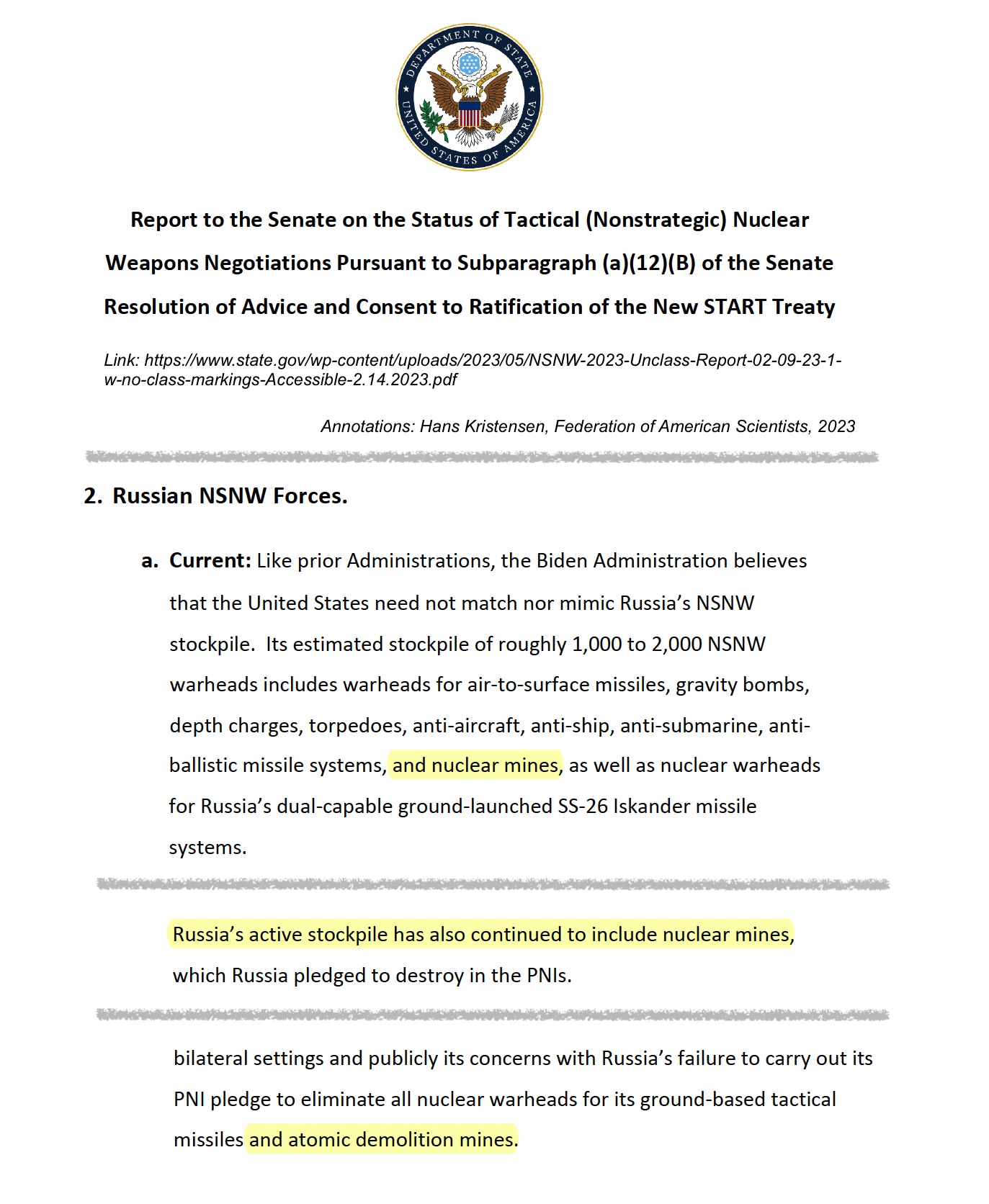
Recent U.S. Intelligence reports refer repeatedly to the existence of Russian nuclear landmines, although it is uncertain how operational they are. The reports do not refer to nuclear artillery.
Russian Non-Strategic Nuclear Weapons
The Trump administration’s Nuclear Posture Review in 2018 estimated that Russia had “up to 2,000” non-strategic nuclear weapons (this was close to the estimate we provided the same year). The NPR estimate was a significant reduction from the “3-5 thousand” Russian warheads listed by Principal Deputy Under Secretary of Defense for Policy James Miller in a briefing to NATO in 2009. Subsequent estimates published by the U.S. Intelligence Community (see above) indicate that the 2018 NPR number was at the high end of an estimated range of 1,000-2,000 warheads. Plotting these numbers from the much higher estimated inventory at the end of the Cold War shows this reduction of the Russian non-strategic nuclear weapons arsenal:
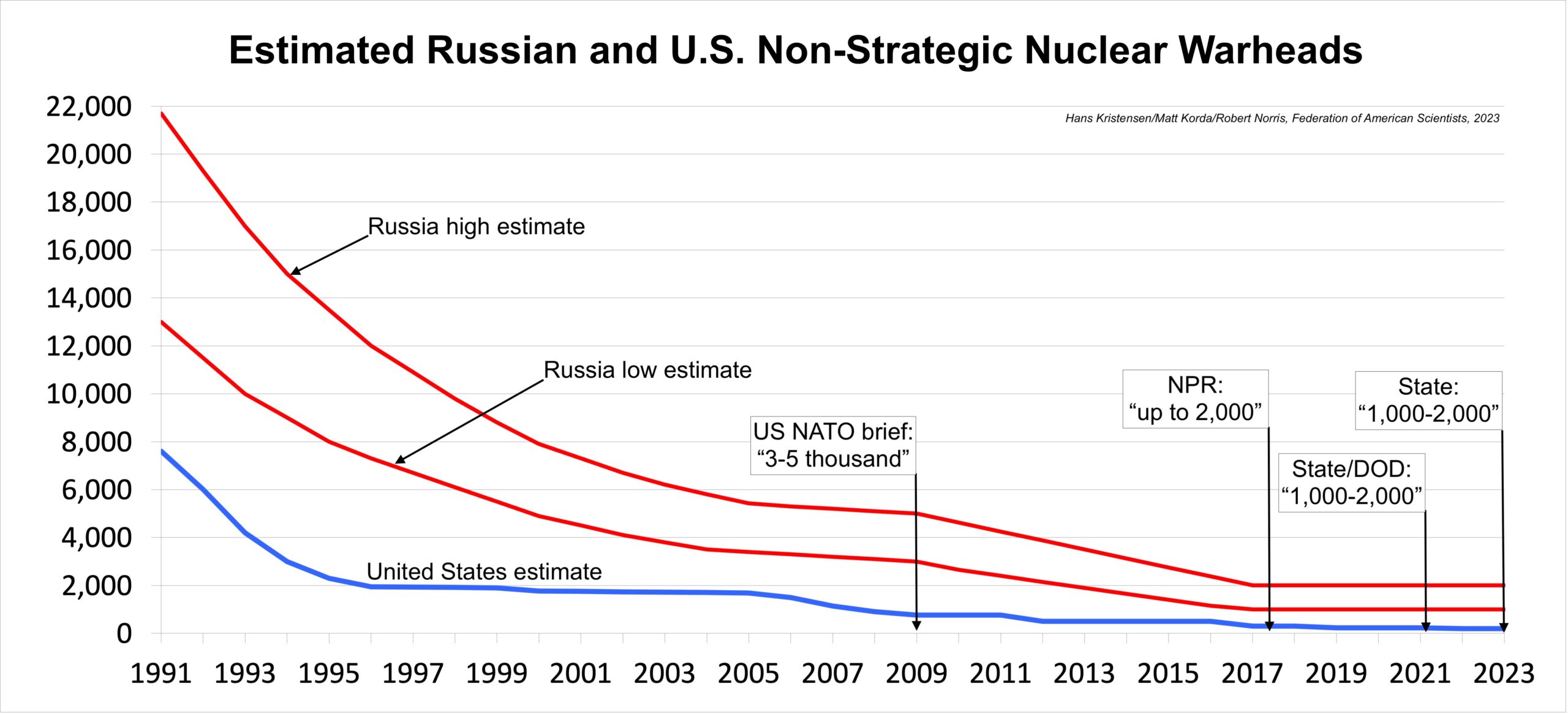
Russia’s stockpile of nuclear warheads for non-strategic forces has decreased significantly since the early-1990s – even during the past 15 years – and is estimated to be down to 1,000-2,000 warheads (including retired warheads awaiting dismantlement).
Interestingly, the U.S. State Department stated in 2022 that the Russian “active stockpile” of 1,000-2,000 non-strategic nuclear warheads included “warheads awaiting dismantlement…” This is curious because in the United States, warheads awaiting dismantlement are not considered “active” or part of an “active stockpile.” Rather, “active” warheads are part of the Department of Defense stockpile that includes both active and inactive warheads. “Active” warheads have all components installed; inactive warheads would need to have those components reinstalled first in order to be able to function.
This suggests that some of the Russian non-strategic warheads that are frequently portrayed in the public debate as part of the arsenal may in fact be retired warheads awaiting dismantlement. Although uncertain, nuclear landmines might be part of that inventory (nuclear artillery shells may be another part of the “awaiting dismantlement” inventory).
In addition to the uncertainty about the status of landmines in the Russian arsenal, advocates for modernization of the U.S. nuclear arsenal have claimed that Russian is expanding its non-strategic nuclear arsenal. Former STRATCOM commander Admiral Charles Richard told Congress in 2020 that “Russia’s overall nuclear stockpile is likely to grow significantly over the next decade – growth driven primarily by a projected increase in Russia’s non-strategic nuclear weapons.” (Emphasis added.)
The basis for that projection is unknown and uncertain. Russia is certainly modernizing its arsenal and fielding more types of weapons that the U.S. intelligence community claims are dual-capable. But how many of those launchers will actually be assigned nuclear warheads is another question. The latest U.S. State Department report acknowledges a Russian increase but cautions that “by how much is uncertain.”
Warhead projections are partially influenced by the expected growth of delivery platform deployments. But just because the number of dual-capable launchers in a weapons category is increasing doesn’t necessarily therefore mean that the number of warheads assigned to that weapons category is also increasing.
In the U.S. nuclear arsenal, for example, not all dual-capable F-15E and F-16 fighter-bombers are assigned nuclear weapons. And just because the F-35A Block 4 upgrade is intended to facilitate integration of nuclear technology, doesn’t therefore mean that all F-35A will be part of the nuclear posture and assigned nuclear weapons.
Simplistic dual-capable launcher counting as a basis for warhead projections could lead to exaggerated numbers.
So, there is much uncertainty about Russian non-strategic nuclear weapons and how the U.S. Intelligence Community makes projections about them. A first step to reducing that uncertainty is to ask questions.
Additional background: Nuclear Notebook: Russian Nuclear Weapons, 2023
This research was carried out with generous contributions from the John D. and Catherine T. MacArthur Foundation, the New-Land Foundation, Ploughshares Fund, the Prospect Hill Foundation, Longview Philanthropy, the Stewart R. Mott Foundation, the Future of Life Institute, Open Philanthropy, and individual donors.
Russian Nuclear Weapons Deployment Plans in Belarus: Is There Visual Confirmation?
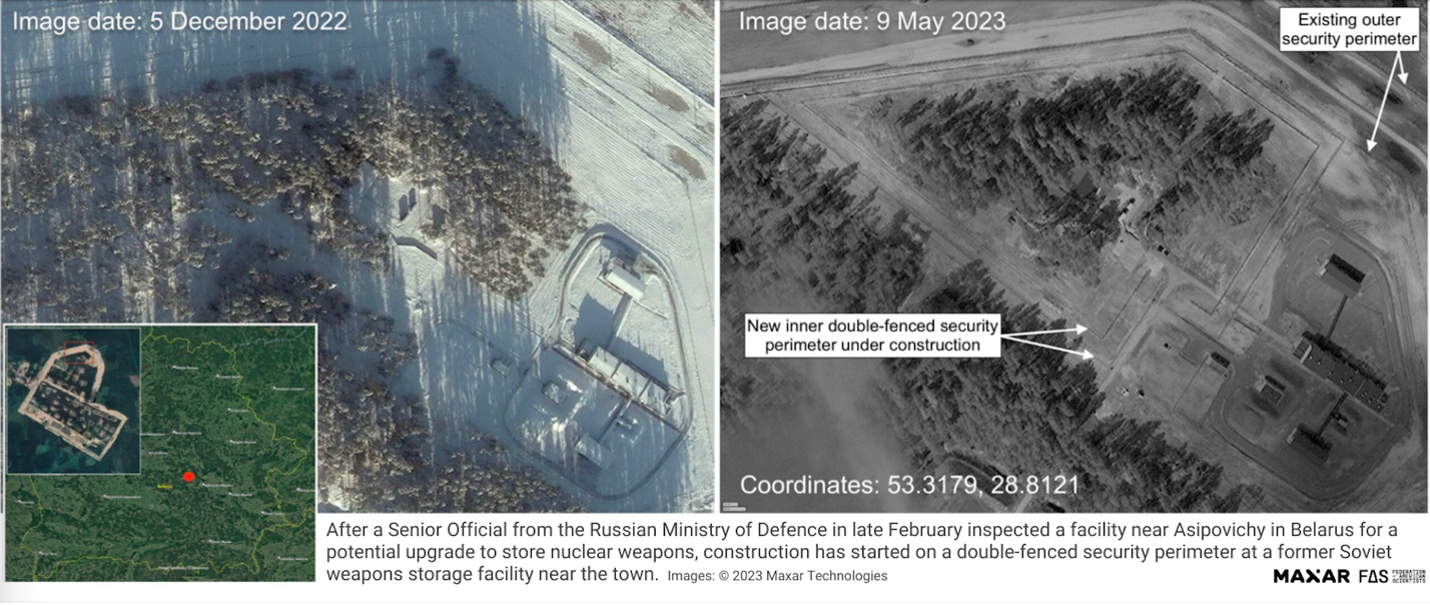
Shortly after a Russian defense official inspected possible nuclear weapons storage site near Asipovichy, construction of additional security perimeters began at depot.
New satellite images show that the construction of a double-fenced security perimeter is underway at a weapons depot near the town of Asipovichy in central Belarus.
The US Central Intelligence Agency reported in late-February 2023 that a senior officer from the Russian Ministry of Defense had inspected a facility in the vicinity of Asipovichy (occasionally also spelled Osipovichi) for a potential upgrade to nuclear weapons storage.
Asipovichy is the deployment area for the dual-capable Iskander (SS-26) launchers that Russia supplied to Belarus in 2022. Interestingly, the weapons depot featured in this article is roughly only 25 kilometers southeast of a vacant military base that, according to the New York Times, could be used to house relocated Wagner Group fighters in Belarus. This does not, however, imply any connection between the Wagner Group and Russian nuclear deployments in Belarus, which would be overseen by the Russian Ministry of Defence’s 12th Main Directorate (also known as the 12th GUMO).
President Vladimir Putin announced in March that Russia plans to complete a nuclear weapons storage site in Belarus by July 1st, 2023, but he later modified the timeline to July 7th-8th, apparently due to delays with preparing the storage facilities.
It is important to emphasize upfront that at this stage, we are not able to make a positive identification that this site is intended for or will definitively be used to store Russian nuclear weapons in Belarus. As we discuss in detail below, while the construction timeline and some signatures correlate with a potential nuclear storage site, other signatures do not, and these raise uncertainty about the purpose of the upgrade at the Asipovichy depot. In fact, overall, we are underwhelmed by the lack of visual evidence of the construction and infrastructure that would be expected to support the deployment of Russian nuclear weapons in Belarus. We have also surveyed satellite imagery of numerous other military facilities at locations mentioned in various reports, but we have yet to find visual evidence that conclusively indicates the presence of an active nuclear weapons facility on the territory of Belarus.
Below we survey facilities at various locations in Belarus that have been mentioned in the public debate as potential transit or deployment areas for nuclear-capable forces or even nuclear weapons.

Iskander Missile Launchers
Asipovichy is an important region because it is the location of new nuclear-capable Islander short-range missile launchers that Russia transferred to Belarus in 2022. One Belarusian news report stated the transfer happened in December, but satellite images show what appear to be Iskander launchers at the training site to the west of Asipovichy in August and October 2022 (see images below).

Iskander launchers have been observed at a training range west of Asipovichy several times.
The Russian Ministry of Defense announced in late-April 2023 that Belarusian personnel had completed training in maintenance and use of “special tactical warheads [Russ: “boyepripas”] for the Iskander-M operational tactical missile system” at one of Russia’s Southern Military District ranges in early April.
The Belarusian brigade base for the Iskander launchers is thought to be located in the southern outskirts of Asipovichy, roughly seven miles west of the depot undergoing upgrades. Some five miles to the west of that garrison, there is a training range where Iskander launches have been seen on several occasions (see image below).
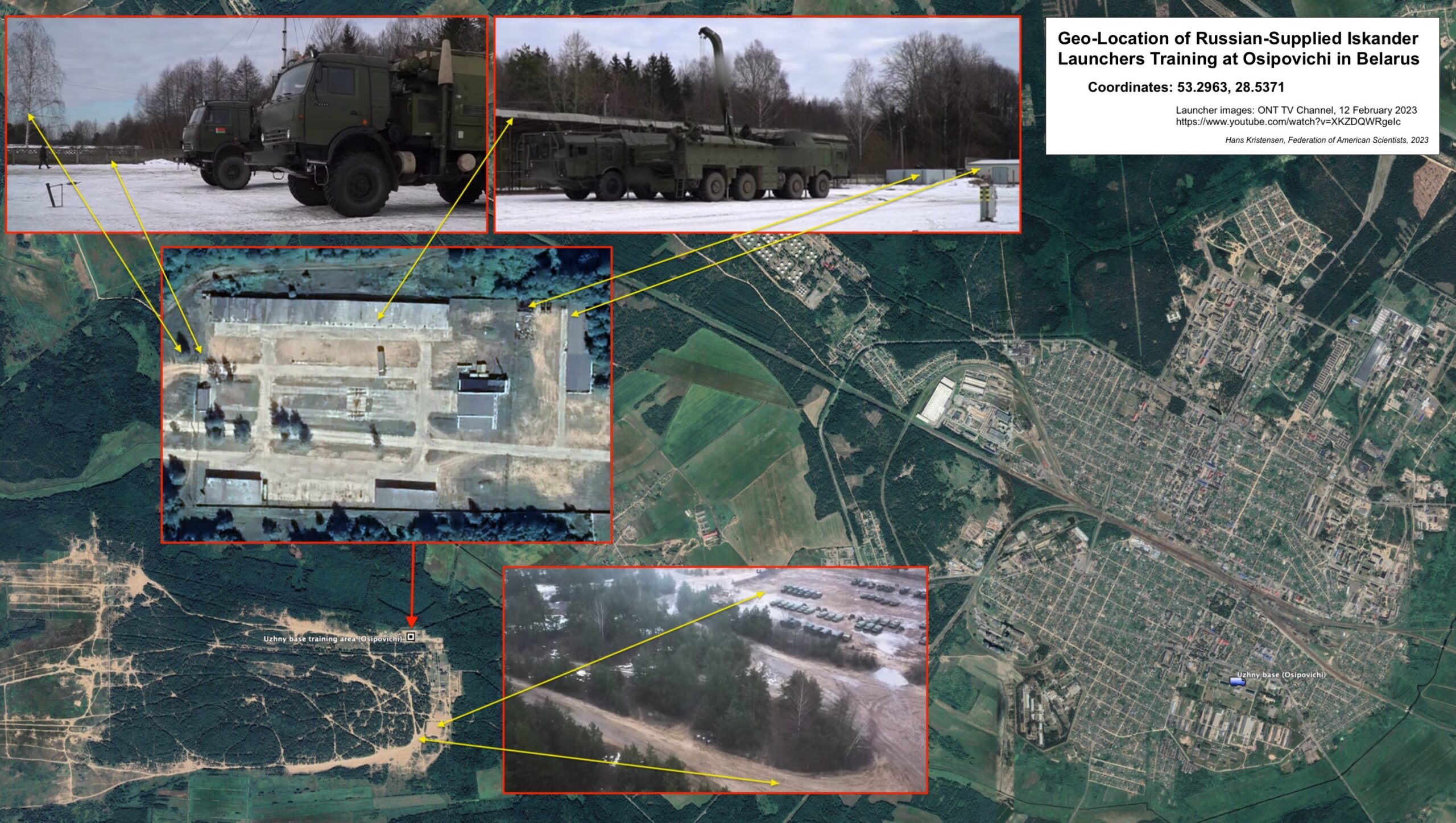
Belarusian Iskander military photos were geolocation to the training range west of Asipovichy.
Most Russian Iskander bases have extensive support facilities as well as a distinctive missile storage site (see image below). No similar facility has been found near Asipovichy. The Belarusian military probably uses different storage standards and could potentially use the dirt-covered bunkers in the south-west corner of the facility.
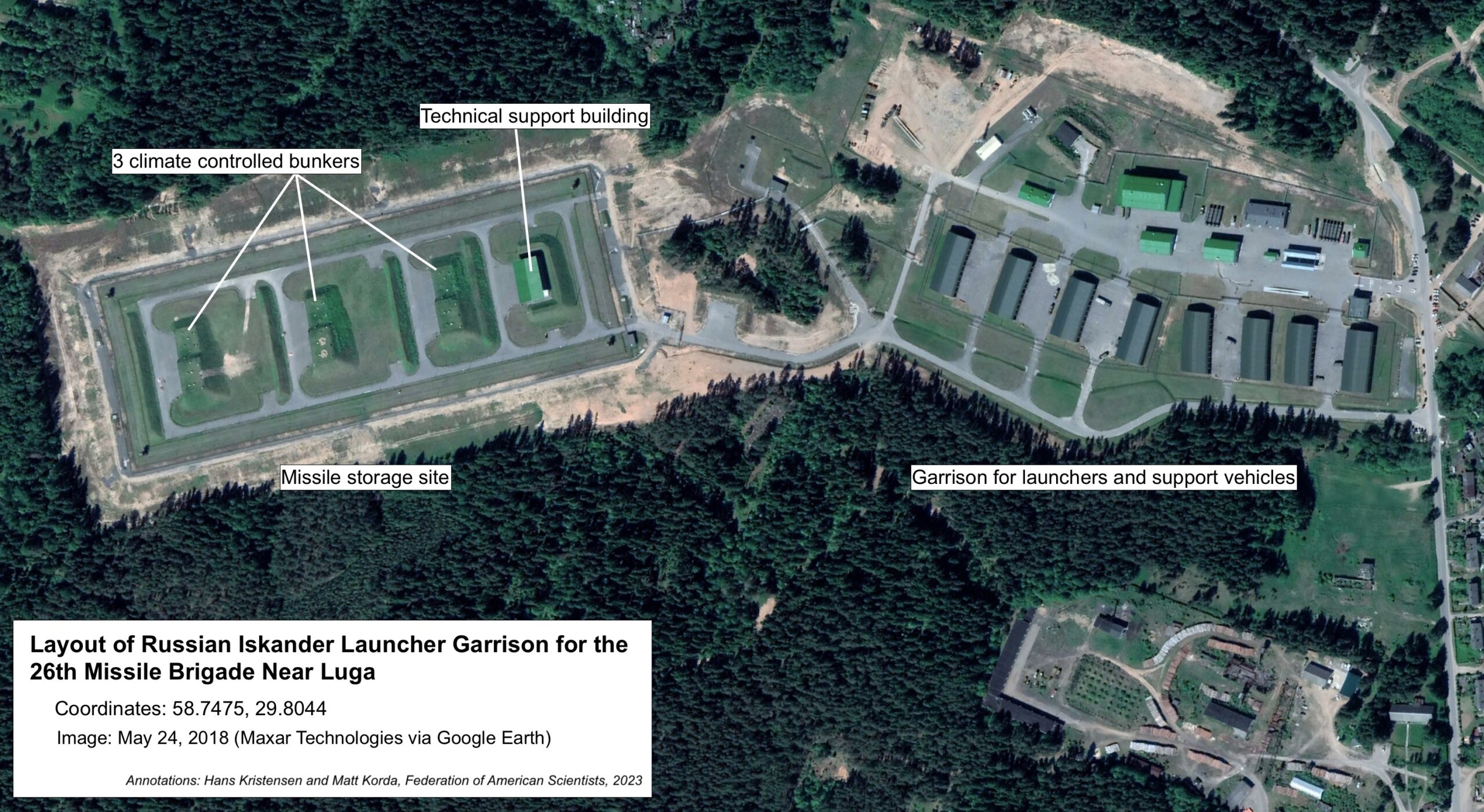
The Belarusian Iskander base does not include the distinctive missile storage site found at most Russian Iskander bases.
A few Russian Iskander bases also do not have the more elaborate missile storage site. That includes the Iskander base in Kaliningrad.
Fighter-Bomber Aircraft
In their public remarks during a meeting in St. Petersburg on 25 June 2022, Presidents Putin and Lukashenko explicitly mentioned nuclear upgrade of Belarusian Su-25 aircraft. A year later, on 14 April 2023, the Belarusian Ministry of Defense published a video of what appeared to be an Su-25 pilot at Lida Air Base explaining the new nuclear role.
An examination of the Lida base area shows no physical indications of upgrades of the kind that are thought would be required to support nuclear weapons deployment. The very latest imagery shows early construction of what appears to be an additional security perimeter around the munitions storage area at the base (see image below). It is too soon to tell, but as in the case of the Asipovichy upgrade, a second fence security perimeter does not necessarily suggest a nuclear weapons upgrade; it could simply be improvement of an existing security infrastructure.
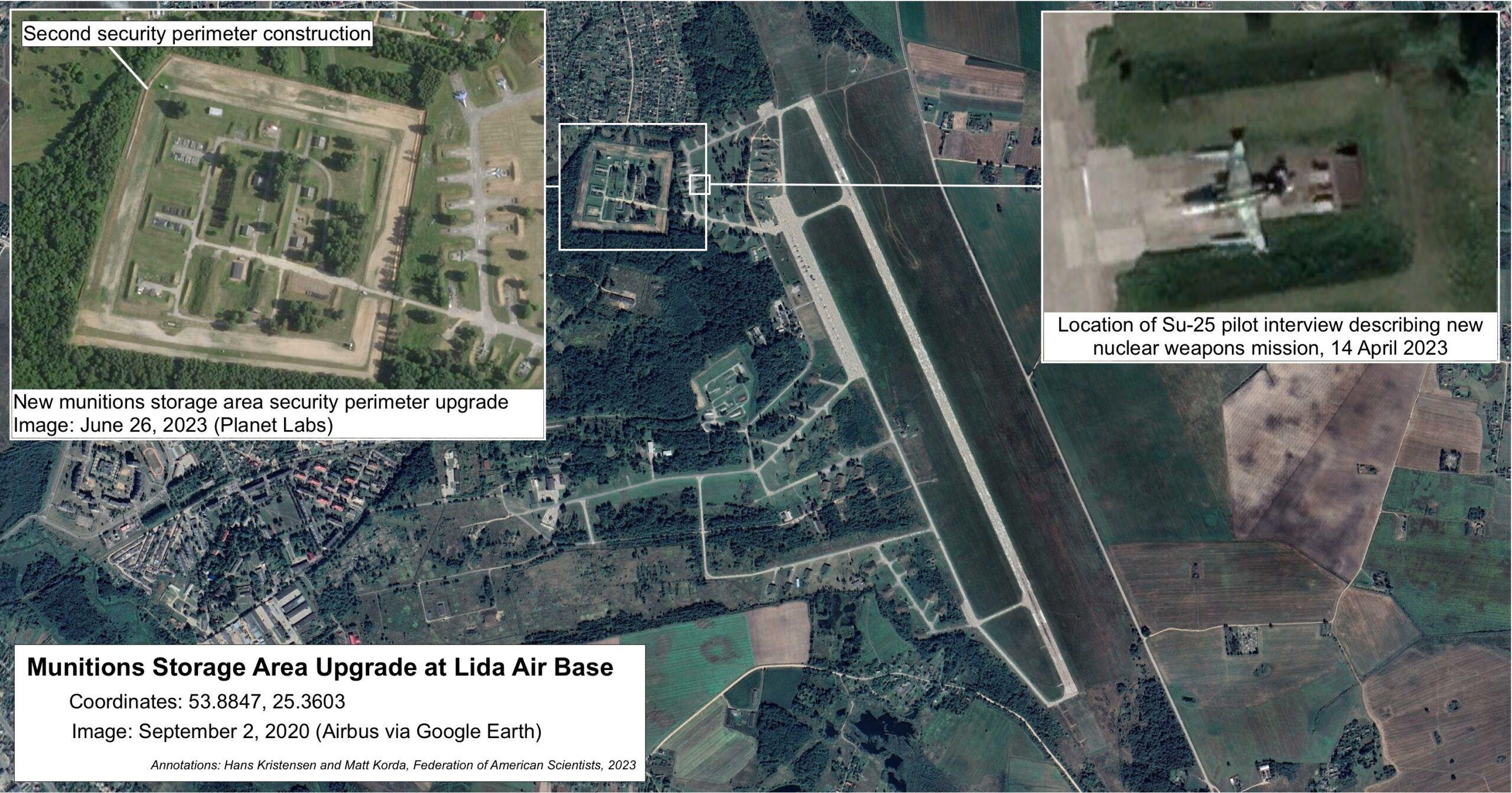
Construction of a second security perimeter at Lida Air Base has begun but there is yet no clear indication this is related to nuclear weapons.
There have also been some speculations that the Baranavichy Air Base further to the south, which is equipped with more modern Su-30SM jets, might be a potential candidate for the nuclear mission. We are not aware of any official statements to that effect and have not seen any observable indications of physical upgrades needed to support nuclear operations there.
As with the Iskander base area upgrades near Asipovichy, we can’t positively exclude the existence of an undetected facility near the western air bases. But so far, we don’t see conclusive physical indications of nuclear weapons related upgrades on or near Lida or Baranavichy. It is also relevant to mention that both bases are very close to NATO territory; Lida is only about 20 miles (35 kilometers) from Lithuania.
Warhead Transportation
On June 16th, Putin announced: “The first nuclear weapons have been delivered to Belarus, but only the first batch. There will be more. By the end of the summer, by the end of this year, we will complete this work.”
Careful monitoring of the 12th GUMO’s transit hub at Sergiev Posad has not yet indicated the shipment of specialized nuclear-related materials, such as fencing, certified loading equipment, vault doors, or environmental control systems. However, on June 27th, a group that monitors the Belarusian railway industry reported that nuclear weapons and related equipment would be delivered to Belarus in two stages, one in June and one in November––echoing Putin’s delivery timeline. The group reported that the shipments would involve three departures planned from Potanino, Lozhok, and Cheboksary stations in Russia, arriving at Prudok station in Belarus––more than 200 kilometers north of the Asipovichy depot. These locations in Russia are hundreds of kilometers away from known nuclear storage sites, and so could either be locations for subcomponents or security equipment rather than the warheads themselves, or they could potentially be an attempt to obfuscate where the warheads would actually be coming from.
Preparation of rail transfer points and storage would require construction of a number of unique security features and support facilities. An examination of satellite images of the Prudok station area in Belarus, however, revealed no observable indication of construction needed to safeguard nuclear weapons (see image below).

Satellite imagery of the Prudok rail station and depot area reported as the first transfer point of Russian nuclear weapons into Belarus show no observable indication of preparations to nuclear weapons storage.
Many Uncertainties
It is important to be clear that these satellite images do not prove decisively that the construction at Asipovichy or other known facilities is related to nuclear weapons storage. It could potentially be related to non-nuclear weapon systems, such as air-defense missiles. There are several uncertainties that should be mentioned and carefully considered:
First, the security perimeter has two inner fences, less than the three or four normally seen at Russia nuclear weapons storage sites. This is a significant difference, because the standard of at least three layers of fencing is directly correlated with the ability of the fence disturbance system to detect security threats to the complex. Fewer layers of fencing (and thus less clear space) could cause the microwave detection system to be accidentally triggered by movement inside the complex itself. To avoid that, vegetation has been removed along the new 12-meter wide inner security perimeter. Construction is ongoing and there is so far no visual indication of electronic sensors inside the new perimeter.
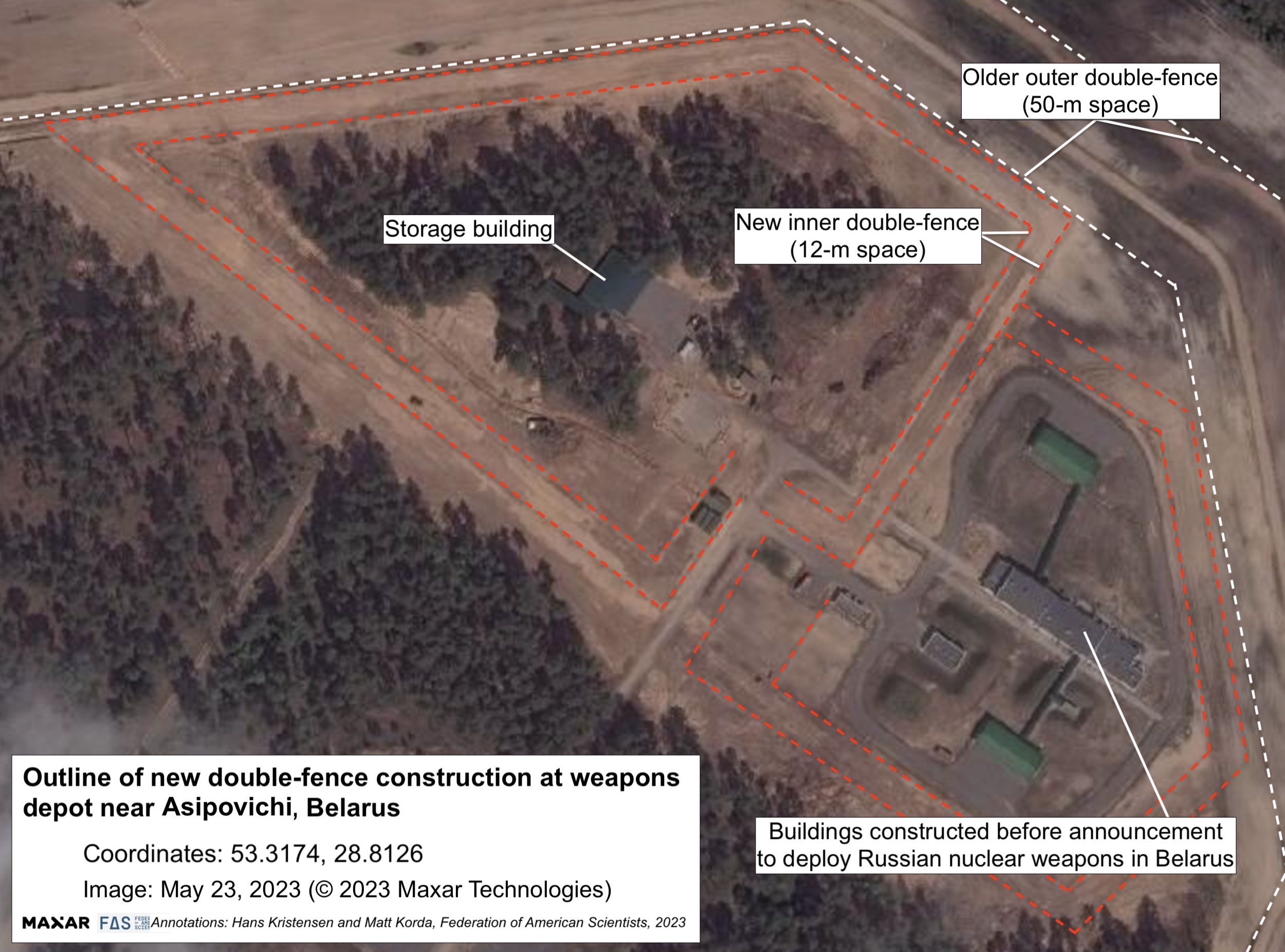
Construction of an additional double-fence security perimeter began at a weapons depot east of Asipovichy in central Belarus shortly after a senior Russian defense official inspected a facility in the area for potential storage of nuclear weapons
In comparison, Russian base- and national-level nuclear weapons storage facilities have extensive security features. The base-level storage facility near Tver approximately 325 kilometers (200 miles) from the Belarusian border has considerably stronger security features around the weapons bunkers (see image below).
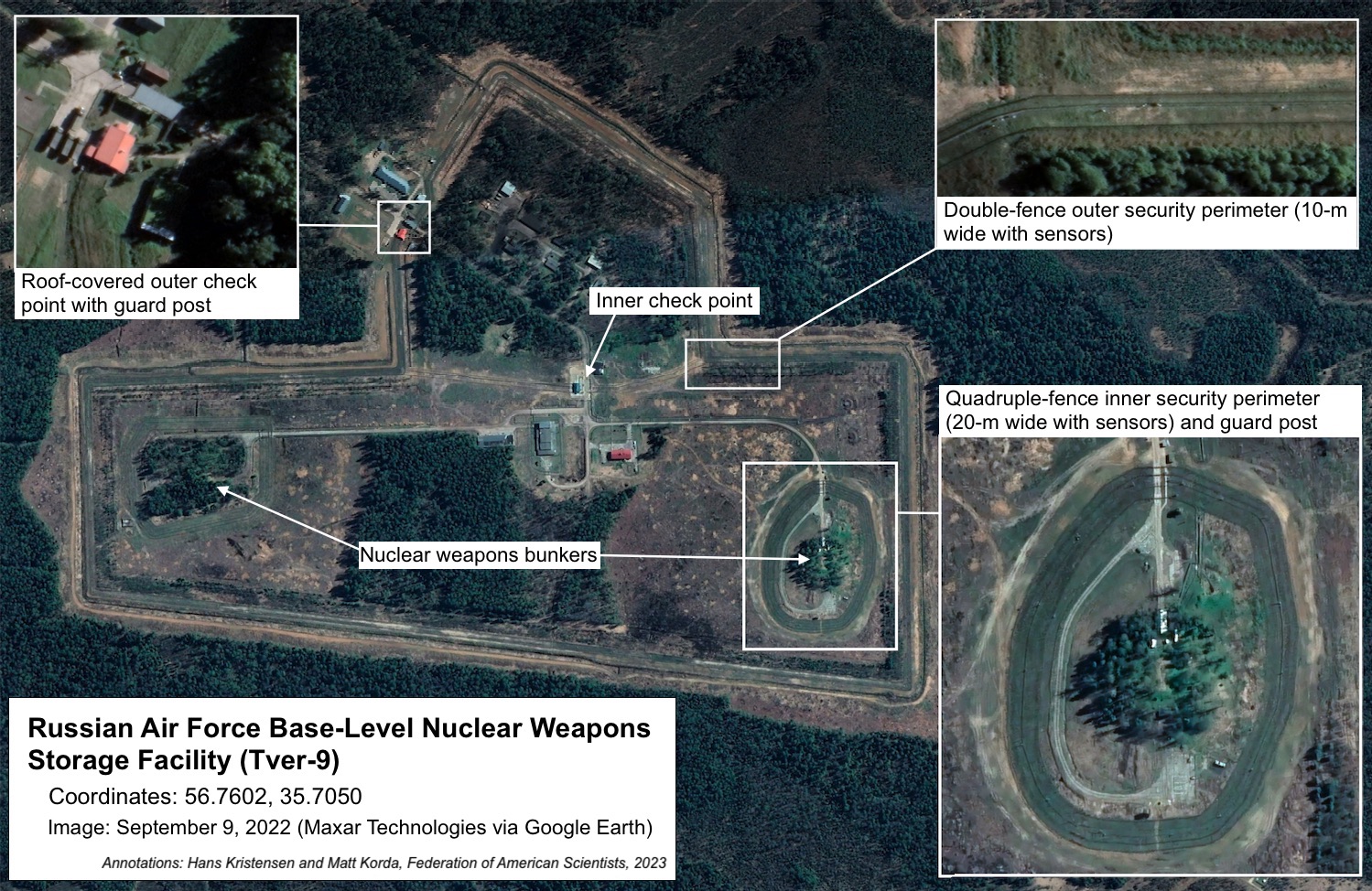
The outline of this Russian base-level nuclear weapons storage site near Tver is very different from the Asipovichy site.
Second, there is no bunker visible inside the enclosure, another normal feature of Russian nuclear weapon storage sites. Apart from physical protection, nuclear weapons require climate-controlled storage facilities.
Third, there is no visible segregated housing for the large number of Russian 12th GUMO personnel that would be needed to protect and manage nuclear warheads.
Fourth, the depot is next to a storage site for conventional high explosives. As other researchers have pointed out, it would be highly unusual for conventional and nuclear warheads to be stored within the same perimeter in order to maintain the security of the warheads and to segregate the chain of custody between Russian 12th GUMO personnel and Belarusian army personnel.
These differences could potentially be explained if the Belarusian site is a temporary transit site and not intended for permanent storage, but rather to introduce nuclear weapons in a crisis.
It is also curious that part of the new double-fence construction extends around a group of buildings that were constructed in 2017-2018, long before any statements were made about deploying Russian nuclear weapons in Belarus.
Even if Russia intends to follow through on its planned construction of a storage site in Belarus, it is not guaranteed that any nuclear weapons would actually cross the border in peacetime. Rather, it is possible that Russia’s actions instead constitute the building blocks for a potential future decision on deployment. Moreover, some analysts have suggested that these actions could be deliberately designed to remind the West of Russia’s nuclear-armed status, rather than actually shift Russian force posture.
In total, the facility upgrade at Asipovichy is important to monitor given the CIA report about Russia nuclear-related storage inspections in the area. So far, however, our observations and analyses show no clear observable indicators of construction of the facilities we expect would be needed to support transport and deployment of Russian nuclear weapons into Belarus. As always, we don’t know what we don’t know and it is of course possible that there are other facilities that we are not aware of that would indicate nuclear weapons activities.
Positive identification of this and other potential facilities will have to await additional information. And we look forward to the contribution of other researchers.
This research was carried out with generous contributions from the John D. and Catherine T. MacArthur Foundation, the New-Land Foundation, Ploughshares Fund, the Prospect Hill Foundation, Longview Philanthropy, the Stewart R. Mott Foundation, the Future of Life Institute, Open Philanthropy, and individual donors.